This guide covers all 51 types of content marketing. With examples of how to use them effectively.
But first, here’s a quick question:
Do you know the difference between “informational” content and “decision-making” content?
If you do, click here to skip ahead to the list of content marketing types.
If you don’t, just keep reading for a quick introduction.
The buyer’s journey goes like this:
People start off by realizing they have a problem to solve.
Then they look at different products or services to figure out which option is best for them.
And finally, they buy it.
To bring people through those stages, you need to use two major types of content marketing:
Informational content at the beginning, when people aren’t actively shopping yet. It introduces people to your brand. And it builds trust with them.
Decision-making content comes later in the process, to actually convince people to buy.

Some content formats can be used for both informational content and decision-making content. But most formats are better for one or the other, as you’ll see.
Read on.
Contents
Blog Posts
Blog posts have a lot of strengths.
First, they’re very “discoverable.” They show up on Google and they’re easy to share on social media.
Second, it doesn’t take special equipment to write a blog post. Anyone with internet access can do it. That has made blogging one of the most popular types of content marketing.
And third, blog posts are super flexible. There are tons of different kinds of articles.
(Like list posts, how-to guides, interviews, FAQs, product reviews, case studies, guest posts, stories, checklists, news, roundups, industry myths, thought leadership pieces and more.)
Here’s a more detailed look at three of the most important kinds of blog posts.
And exactly how you can use them.
List Posts
List posts (also called “list articles” or “listicles”) get 80% more traffic than other types of posts.
They’re an excellent way to get traffic from both organic search and social media.
Most list posts are informational content. But they can also work as decision-making content to drive sales.
It just depends on the topic.
For example, the keyword “richest people in the world” gets 234,000 searches per month globally.

And “Netflix top 10” gets 86,000.

Both of those are informational keywords. People searching for them are looking for general information.
So naturally, a list article about either of them should contain informational content. (And there isn’t much opportunity to sell something.)
But commercial keywords can be paired with decision-making content.
For example, product-specific keywords like “ergonomic office chairs” or “best coolers for camping”. Both of those are more transactional.
People searching for keywords like those are usually shopping. Which makes those keywords a good opportunity to drive a sale with decision-making content.
Like this top-ranking list post for the keyword “best women’s slippers”.
That post includes a review and affiliate link to each product on the list. And it makes a lot of money: according to Ahrefs, the post gets more than 47K visits per month from search traffic.
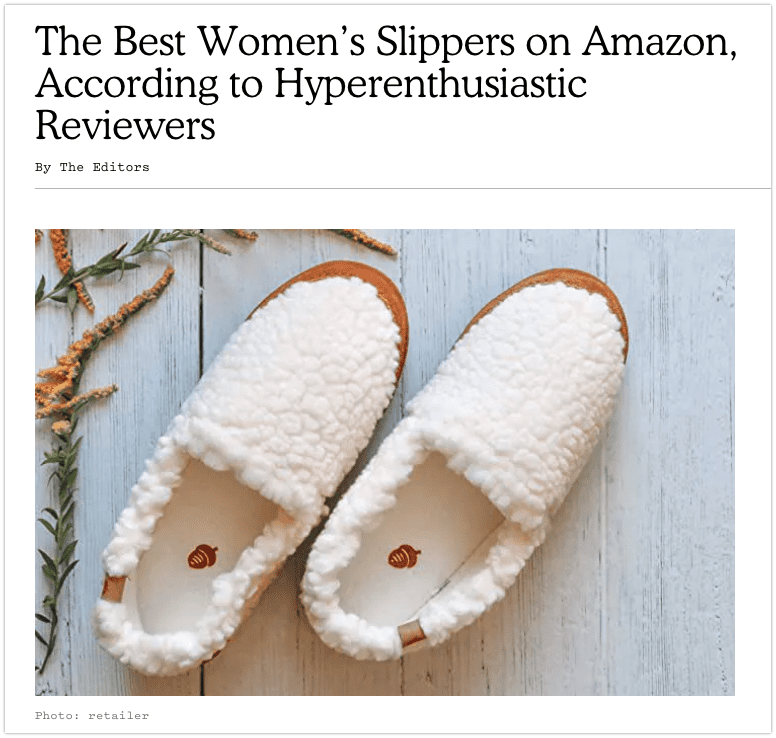
Note:
It can be hard to make a list article stand out. Especially if you’re up against larger competitors.
So if you’re in a competitive niche, it’s a good idea to make your listicles longer and more in-depth than the others that are already out there.
That’s what I did for this list of 70+ useful content marketing tools. There are lots of other listicles about content marketing tools. But none of them include as many details about as many tools as mine does. So mine stands out.
How-To Guides
How-to guides can be used as both informational content and decision-making content. Sometimes a single guide can be both of things at once.
A great, in-depth guide shows the reader how to do something from start to finish. Without leaving big information gaps that they’ll need to Google.
For example, my Complete Guide to Content Distribution. Which covers everything marketers need to know about promoting and distributing content online.
Or this ultimate guide to giving virtual presentations on Zoom. It contains almost 30k words, as well as lots of screenshots and videos. Making it by far the most in-depth guide on the subject.

“X vs Y” Comparison Posts
“X vs Y” blog posts are when you compare two competing products or services.
For example, Slack vs Basecamp. Coke vs Pepsi. Or Airpods vs Airpods Pro.
This type of blog post is mostly decision-making content. Its purpose is to help people to decide which product to buy.
So product brands and affiliate marketers can use this type of content to drive revenue.
Here’s what’s great about comparison posts:
Even though “X vs Y” keywords have a lot of purchase intent, they’re still relatively easy to rank for.
For example:
The keyword “Zendesk vs Salesforce” gets 500 global searches per month and has a keyword difficulty score of 4 according to Ahrefs. Which means it should be very easy to rank for.
Compare that to the keywords “Zendesk review” and “Salesforce review”. As you can see below, those keywords do get a little more traffic. But they have much higher keyword difficulty scores.

This dynamic is common among “X vs Y” keywords. They’re usually much easier to rank for than you’d expect.
Combine that with the purchase intent behind those keywords, and it’s clear that the “X vs Y” comparison post is one of the best types of content to use later in your buyer’s journey, as decision-making content.
For example:
The #1 ranking page for “Zendesk vs Salesforce” is an article by a third competitor called Trengo.
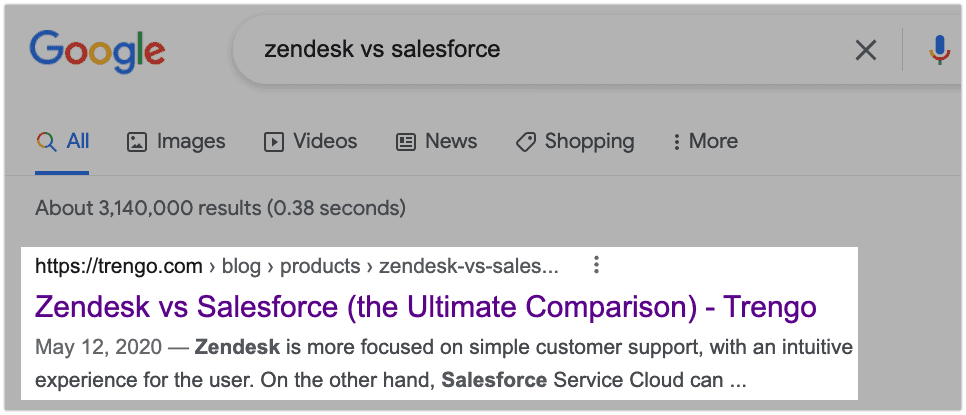
Trengo’s article follows this typical “X vs Y” post structure:
- Introduction and overview
- Features comparison
- Pricing comparison
- Summary of pros and cons
- Conclusion: which to pick
An affiliate marketer would sprinkle their affiliate links to Zendesk and Salesforce throughout the article in order to make money that way.
But Trengo has their own competing product. So what do they do?
Several times in the article, Trengo recommends trying their own product instead of Zendesk or Salesforce.
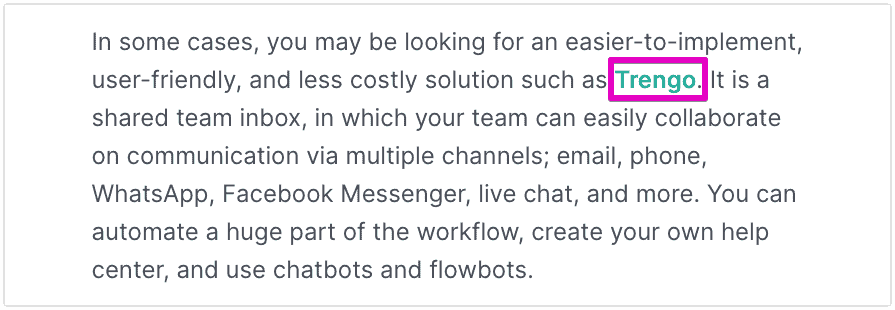
Those references undoubtedly bring in new trials and sales the company would not have made otherwise.
Tip:
For a complete framework on creating high-performing blog posts, see my article The Content Development Framework.
Video Content
People now watch over 1 billion hours of video every day on YouTube alone. YouTube is also the second most popular search engine in the world (after Google).
Clearly, video is a massive opportunity for content marketers. Both on YouTube and elsewhere.
Video content marketing is also very flexible. In fact, it can take many of the same forms that blog posts do.
Including:
- Product reviews
- X vs Y comparisons
- How-to guides
- Lists
And more.
However, the conversion rate from standalone videos is usually very low. So it can be harder to acquire customers with video than from written content.
That makes video suited to informational content.
In other words, video is usually better for building awareness and trust than it is for driving immediate sales. (Though there are exceptions, as you’ll see in a minute.)
Here are some of the best types of video content marketing.
Behind the Scenes
“Behind the scenes” videos cover how something was made in order to promote it.
These videos range from only a few minutes long, to full-length documentaries.
For example, Warner Brothers produces tons of behind the scenes content about their movies. Their YouTube channel is full of them.
Another example is this short video on “Tesla Glass.” It covers how the company makes acoustic glass for its cars, and the benefits the glass provides.
Tesla’s video doesn’t come across as an ad, but it basically is one. And it received over 1 million views in the first month after it was published.

Interviews
It’s a decades-old content marketing tactic:
Actors and musicians promote their new releases by going on talk TV programs like The Late Show. Or YouTube series like Hot Ones, Narduar and others.
You’ll even find celebrity guests on seemingly unrelated channels, like wristwatch channel Hodinkee and tech reviews channel MKBHD. When the product you’re promoting has nearly universal appeal (like movies do), then even the most niche audiences will be relevant.
Authors use this same marketing strategy for their new books.
For example, this interview with Brené Brown on Tim Ferriss’s YouTube channel has over 830k views. And the Audible YouTube channel is full of its own interviews with authors and voice actors.
Entrepreneurs and business executives do the same thing. For example, this interview with Oura CEO Harpreet Rai on This Week in Startups. Or this interview with Canva founder Melanie Perkins on the video podcast How I Built This.
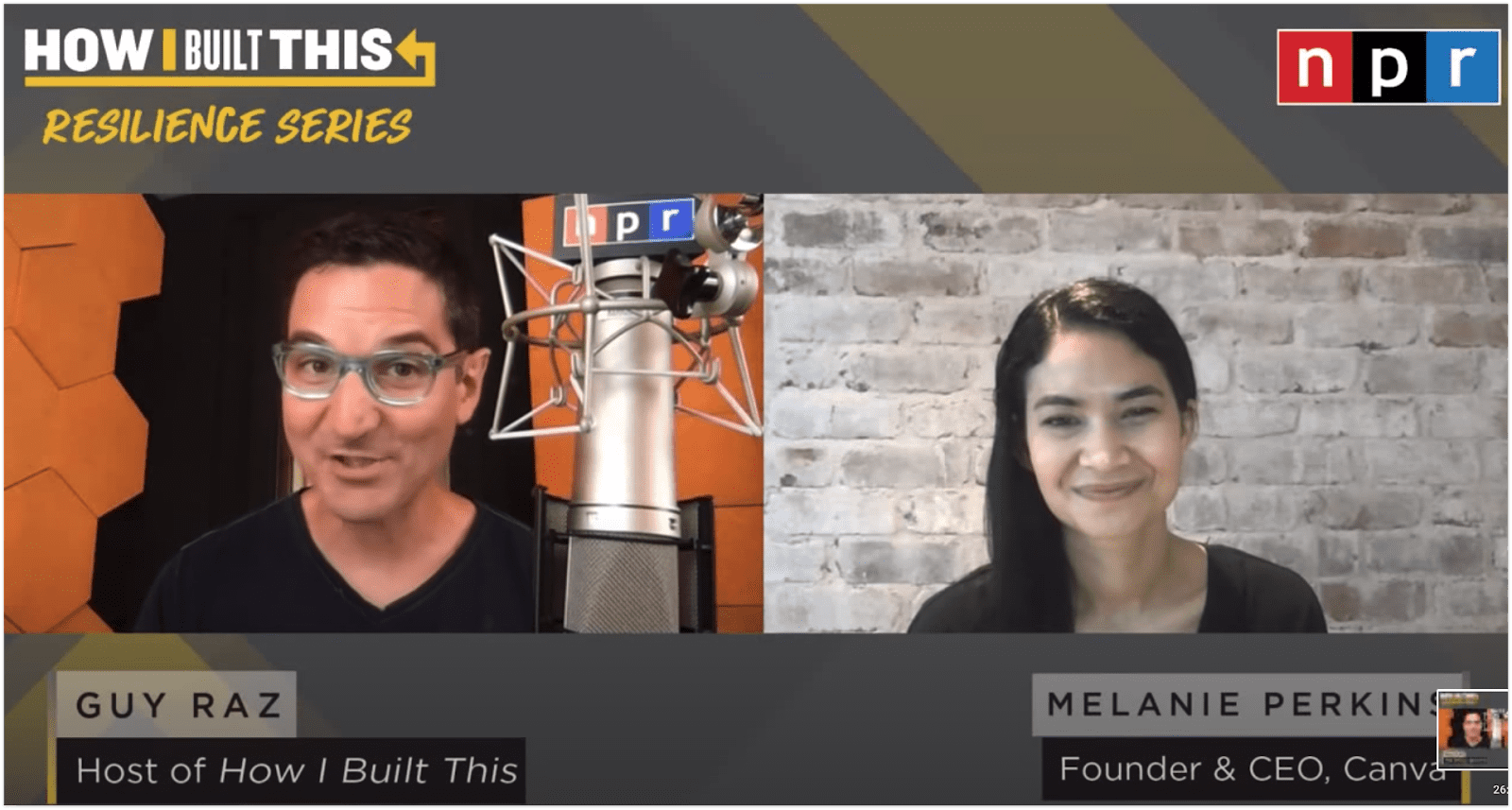
According to Cision, the keys to being a successful interviewee are to:
- Avoid wearing patterns, which often cause visual anomalies on screen.
- Practice the key points you want to say.
- Give your interviewer questions to ask ahead of time, if possible.
- Avoid nervous body language and glancing.
- Speak slowly and clearly.
- Practice ahead of time.
- Wear a friendly, relaxed facial expression.
- Speak in short sentences.
- Breathe deep to relax before the interview starts.
Video Embeds
Embedded video helps your content come to life in a way plain text just can’t.
Whether you add 360° visuals to a product page, cover more angles with an explainer video, or let your customers do the talking with video testimonials on a landing page.
Video embeds can also increase dwell time on blog posts. In other words, they increase the amount of time visitors spend on the page.
That matters because there is evidence that increased dwell time can improve Google rankings.
In fact, articles with embedded video get 12.5 times as much traffic as articles without video.
For example, this SaaStr blog post about the State of the Cloud 2021 report features an embedded video of the complete data presentation.
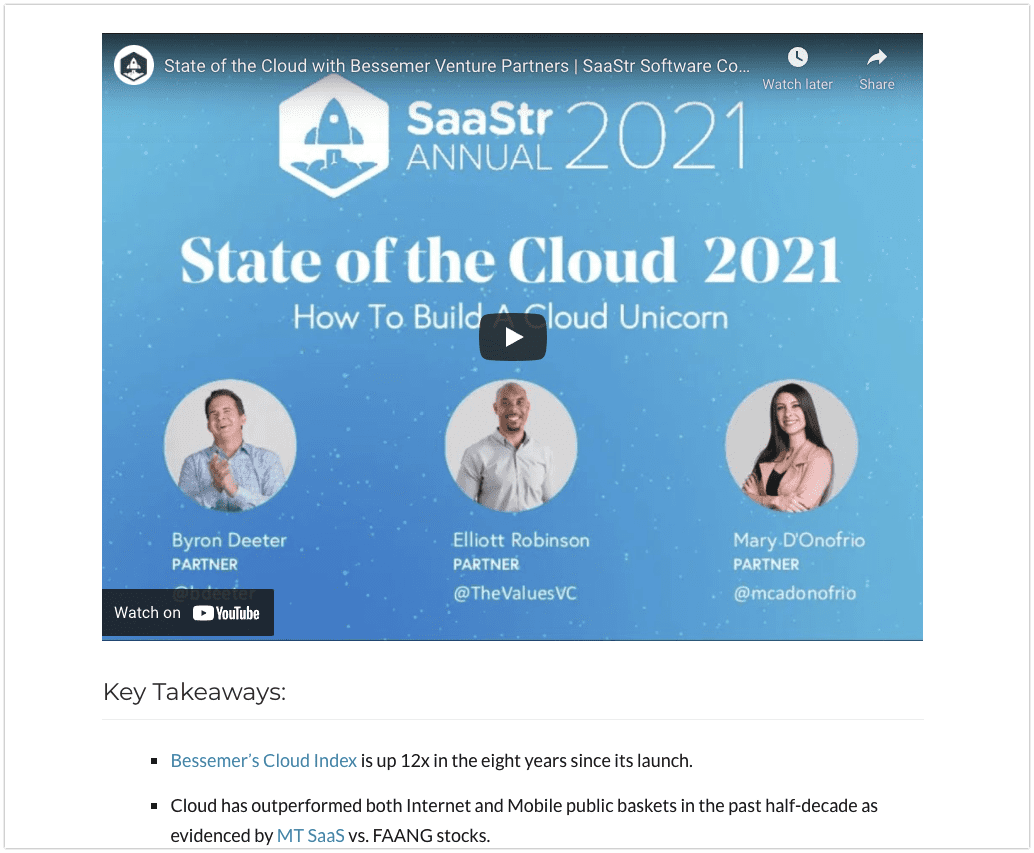
Finally, as I mentioned before, isolated YouTube videos aren’t great at driving sales directly.
But video embeds are a different story. Ecommerce product pages with embedded video convert an incredible 80% better than those without video.
Live Streaming Content
Live streaming is exploding in popularity, with 916 million hours watched in 2020 compared to 629 million in 2019.
And it isn’t just for Twitch gamers.
Almost every major social network has a live streaming option now.
Just to name a few:
YouTube Live
LinkedIn Live
Facebook Live
Instagram Live
TikTok Live
Etc.
So how can you use live streaming?
One way is to boost your subscriber numbers. If you already have a YouTube channel, adding a weekly live stream to your content schedule can bring in up to 40% more subscribers.
Another way is to bring in more viewers for an event.
For example, the live stream of Louis Vuitton’s latest runway show brought in over 130 million viewers.
You can also use live streams as a way to interact with your audience via Q&A sessions or behind-the-scenes insights.
Or take the video content you were going to publish anyway and broadcast it first as a live stream. You can see lots of examples of this on YouTube, or by searching LinkedIn with the hashtag #linkedinlive.
Native Content
Native content is also called sponsored content or native advertising. And it gets 20% – 60% higher engagement rates than regular banner ads do.
But what is native content, exactly?
It’s essentially advertising that looks like regular content. Most influencer marketing is native content, for example.
Native content can be either informational content for spreading awareness, or decision-making content for driving sales.
Here are a few types of native content:
Sponsored Posts and Reviews
Sponsored posts and reviews are types of influencer marketing. They basically work like celebrity endorsements.
And they can be very effective: according to one study, many people now trust recommendations from social media influencers more than they trust suggestions from their own friends.
This sponsored Instagram post from Kendall Jenner is one example of this kind of native content:
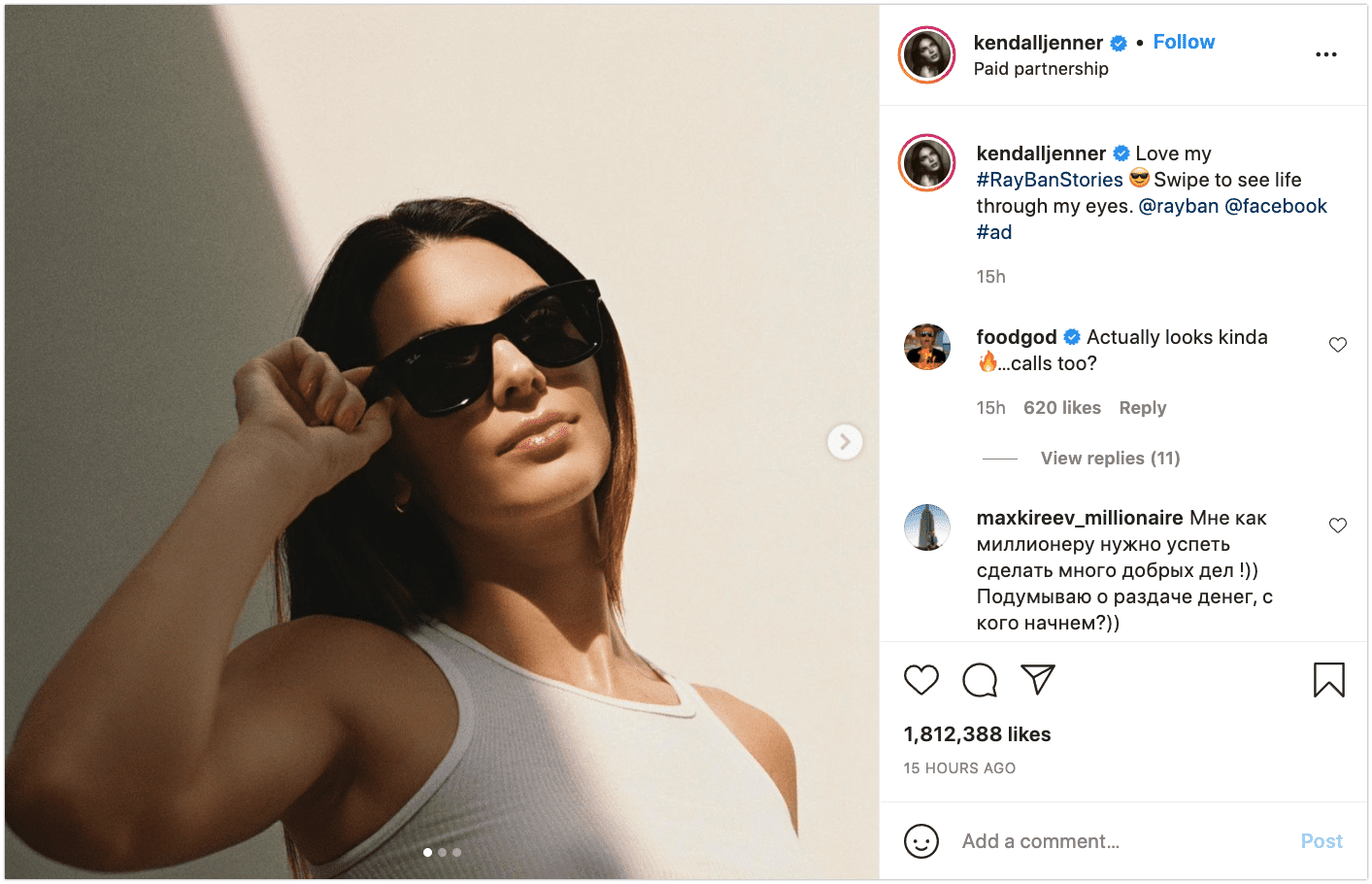
Product Placements
Also called “embedded marketing,” product placements have existed since the 1890s.
Companies spend more than $20 billion per year to place their products in movies, major TV shows, independent streaming series and music videos.

Host-Read Ads
Host-read ads are podcast ads that the host reads to their audience. So they sound like part of the main content.
According to research by Nielsen, host-read podcast ads drive 60% higher information-seeking intent and 50% higher purchase intent compared to traditional podcast ads.
Affiliate Programs
Affiliate programs are technically a little different from native advertising. But they work similarly.
With affiliate marketing, the affiliate or influencer chooses what to say (rather than the advertiser). But the outcome is similar since they’re still paid to promote the product.
Affiliate marketing is so effective that annual spending on it has grown from $1.6 billion in 2010 to a projected $8.2 billion in 2022 in the U.S. alone.
Podcasts
41% of Americans listen to podcasts at least once per month. And that number is growing each year. So it’s no surprise that branded podcasts are one of the fastest-growing forms of content marketing.
Branded podcasts typically focus on informational content to spread brand awareness and build trust.
(Though often, there might be a call to action inviting listeners to subscribe to an email newsletter or try a product.)
There are two main types of podcasts that businesses use for content marketing:
1. Interview podcasts, where hosts typically interview a single guest for each episode. This format acts as marketing for both sides: the host gets access to a high-value guest (who attracts new listeners), while the guest gets access to the host’s audience.
Like ChartMogul’s podcast, where they interview their own SaaS customers — collecting lots of social proof in the process. Or the Mixergy podcast, Smart Passive Income, and many others.
2. Monologue podcasts, which feature one person talking about something.
Monologue podcasts are a great format for how-to content, or for focusing on a specific topic for an entire episode. Like Seth Godin’s Akimbo, which promotes the company’s business workshops.
There are other podcast formats too, of course.
Like conversational panel podcasts, investigative journalism, fictional narratives and more. But the two above are by far the most common ones that are used by businesses for marketing purposes.
And some podcasts mix and match between those formats for different episodes. Like the Plugged In podcast by energy company Con Edison. Or Amy Porterfield’s Online Marketing Made Easy podcast.
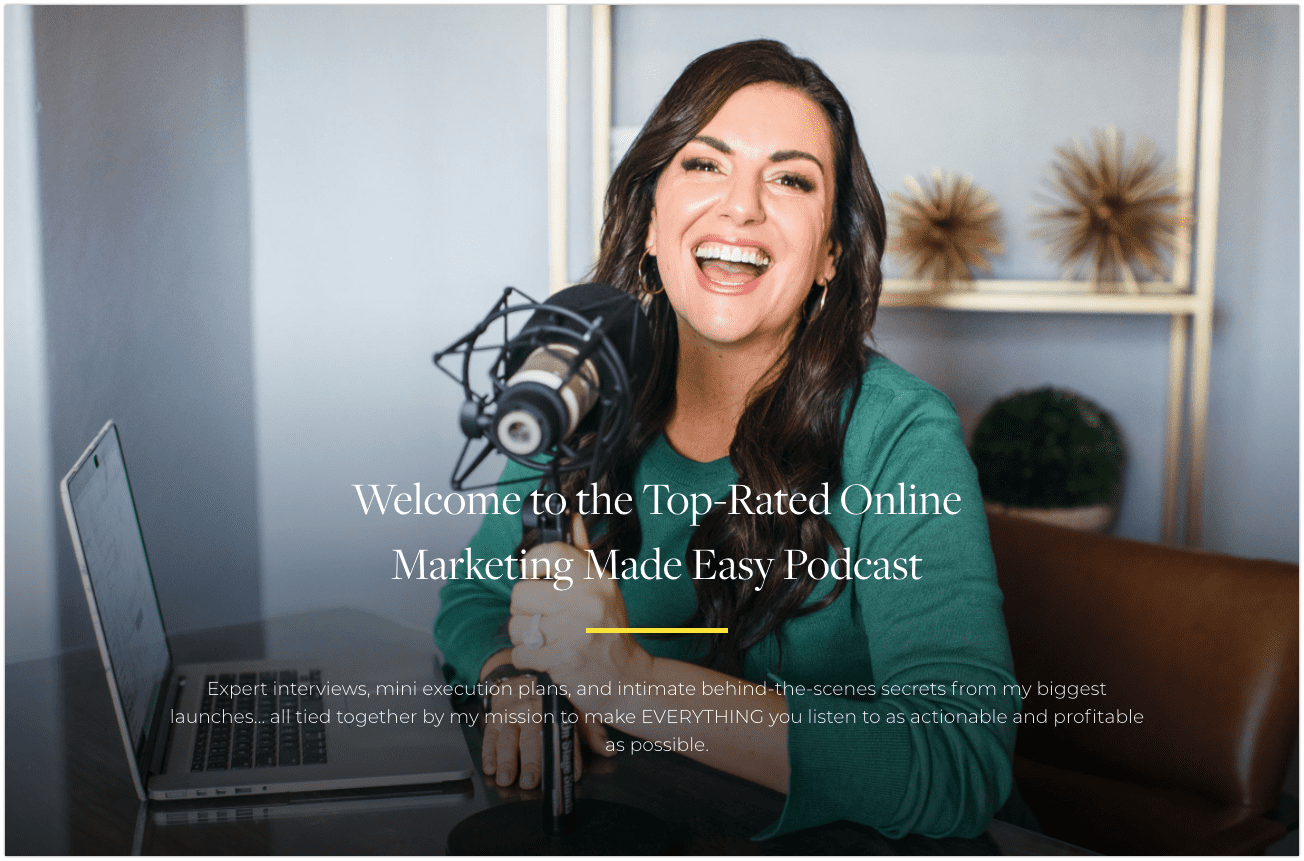
Email Content
Email is an extremely flexible content marketing channel. And it delivers an impressive average ROI of 4200%.
Lots of businesses use email marketing with decision-based content to drive purchases from new and existing customers.
Others use email newsletters strictly for lead nurturing: they deliver a steady stream of informational content to warm up subscribers, building a relationship before their sales team closes the sale.
And many drip email campaigns combine both types of content. They start with a number of informational emails before moving on to pitch a product or service.
Here are some different types of email content marketing:
Content Distribution Emails
Content distribution emails are focused on delivering content to an audience. Either within the email itself, or by linking out.
The vast majority of emails I send to GrowthBadger subscribers are content distribution emails. (By the way, you can sign up to get them here.)
Other email newsletters simply curate other people’s content. Like the #SEOFOMO newsletter by Aleyda Solis.
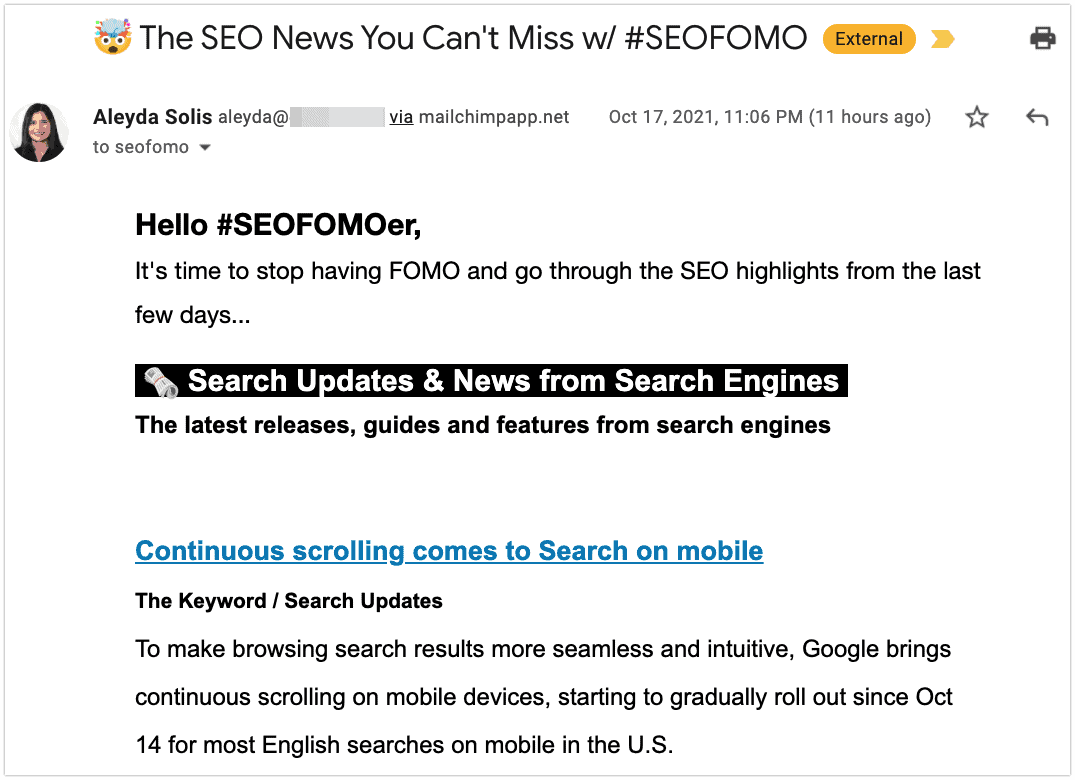
Lead Nurturing Emails
Lead nurturing emails are a type of sales enablement content.
Meaning: they’re not designed to make an immediate sale. Instead, they build trust with subscribers over a period of time to make the eventual sale easier.
For example, here’s a lead nurturing email from the entrepreneur coaching program Strategic Coach.
As you can see, the email starts with a brief introduction, then gives several specific tips to help subscribers with their businesses:
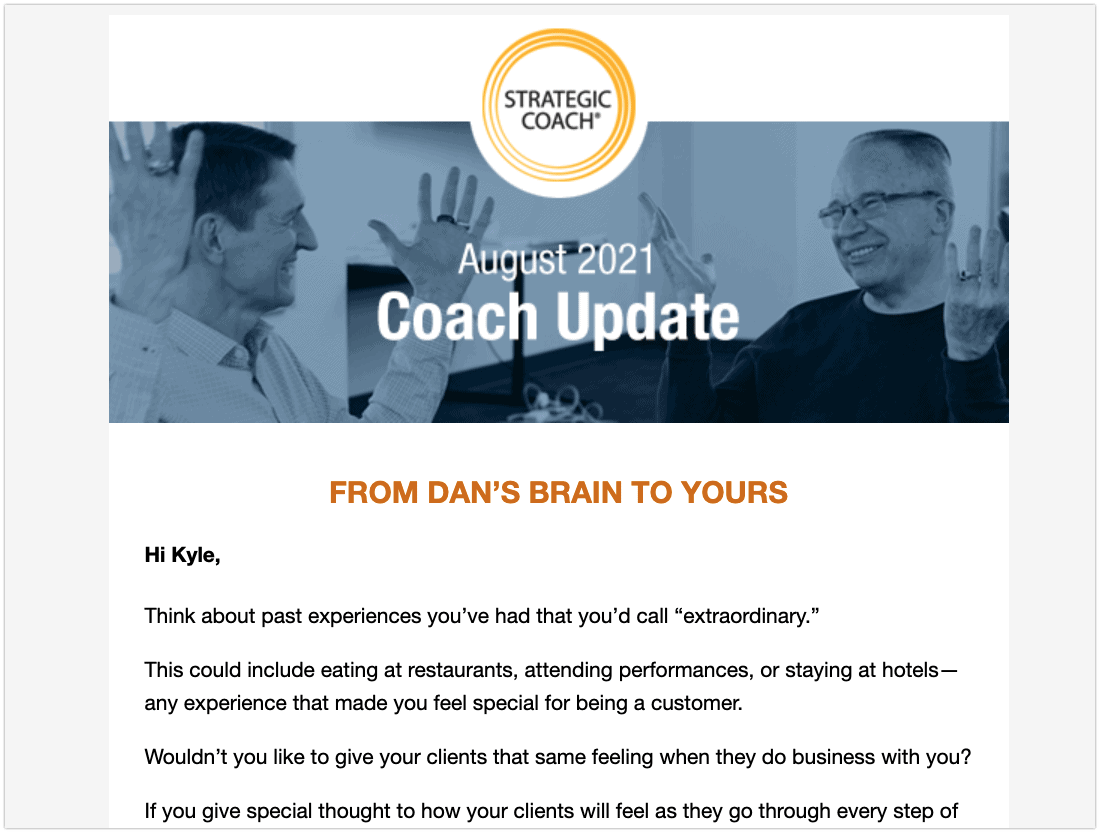
That email never pushes for a sale. It simply provides value in the form of business advice.
And it’s just one part of a long drip email campaign designed to build trust over many months. Gradually moving subscribers closer and closer to purchasing the program.
Promotional Emails
Promotional emails are just what they sound like: emails that get people to buy.
Some promotional emails simply call out new or featured products or services.
Other times, they announce a sale or offer a discount. Like this email from Consumer Reports:
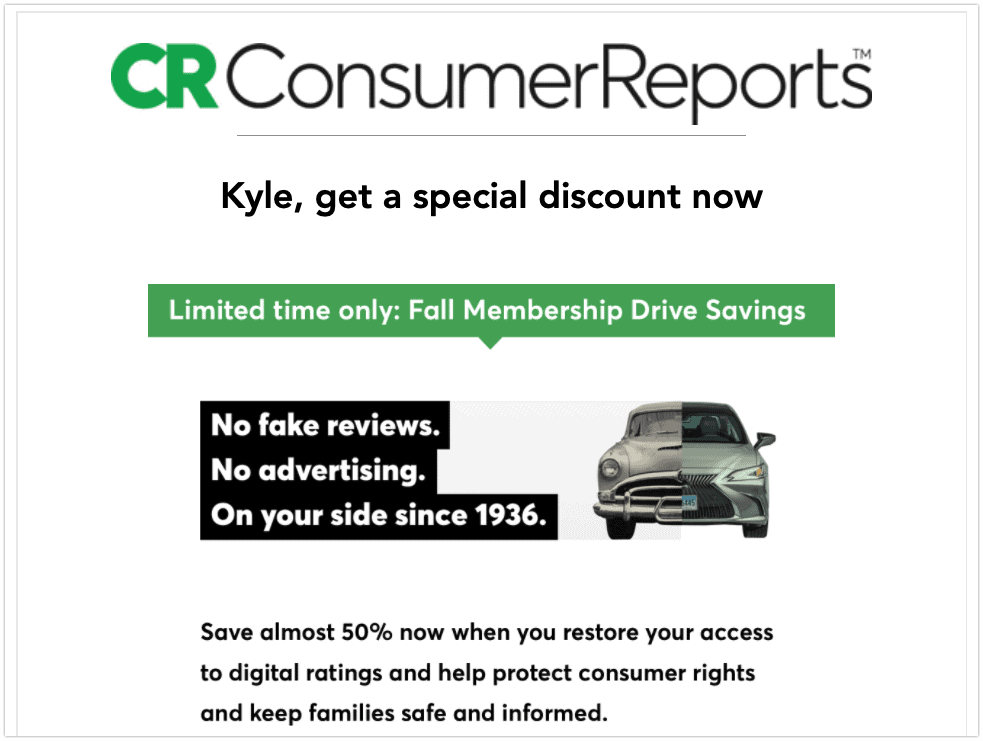
In addition to promotional emails, many businesses send promotional SMS text messages as well.
The typical open rate for SMS marketing is an incredible 82% (compared to email’s 25%).
And lots of email service providers let you send SMS marketing as easily as you can send emails. Including Mailchimp, ConvertKit and Drip.
Email Courses
Email courses consist of around 5-10 lessons on a subject, delivered automatically via an email series.
These are a great way to attract new subscribers. And they can also serve as a type of lead nurturing.
For example, Brennan Dunn offers a free 9-lesson email course for freelancers called Charge What You’re Worth.
At the end of Brennan’s free course, subscribers are sent promotional emails for his full, paid Double Your Freelancing course.
It’s a very simple, automated sales funnel. 100% via email.
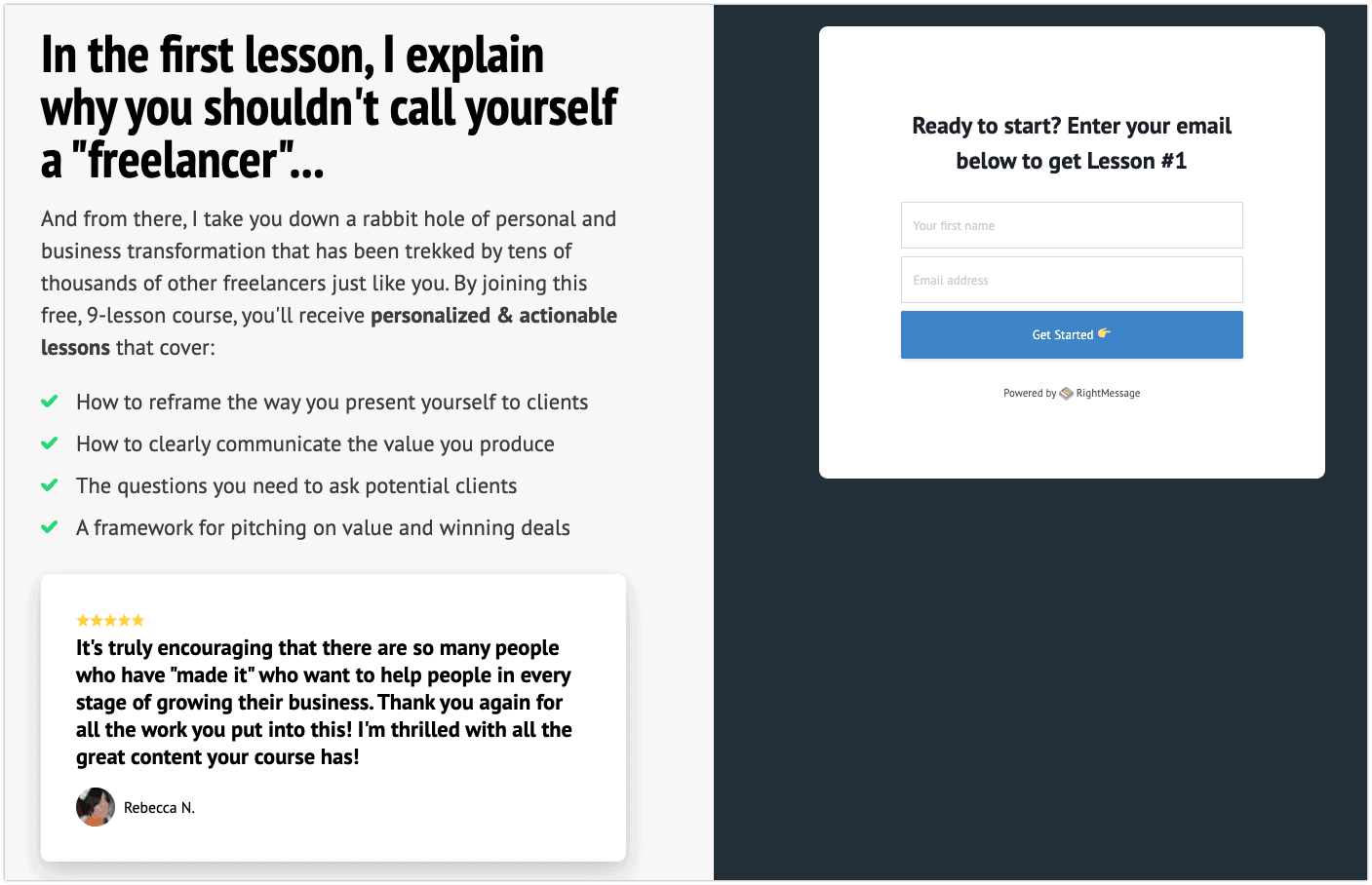
Lifecycle Emails
Lifecycle emails are sent automatically based on the individual subscriber’s behavior.
They can be used to improve customer retention or to spur additional purchases or upgrades.
The most common type of lifecycle email is the welcome email, which goes out when someone first subscribes.
Welcome emails are powerful for one reason:
They have an incredibly high 86% average open rate.
Often, welcome emails include a link for people to confirm their subscription or access bonus material.
And sometimes, they include a question about the subscriber.
For example, my welcome emails end with the question: “What’s your #1 challenge right now?”
With a steady stream of answers to that question, I’ll never run out of content ideas to write about. And I can use that info to segment subscribers into different buckets for marketing purposes.
Welcome emails are also a great place to tell the person what to expect going forward. Like this one from Ramit Sethi does:
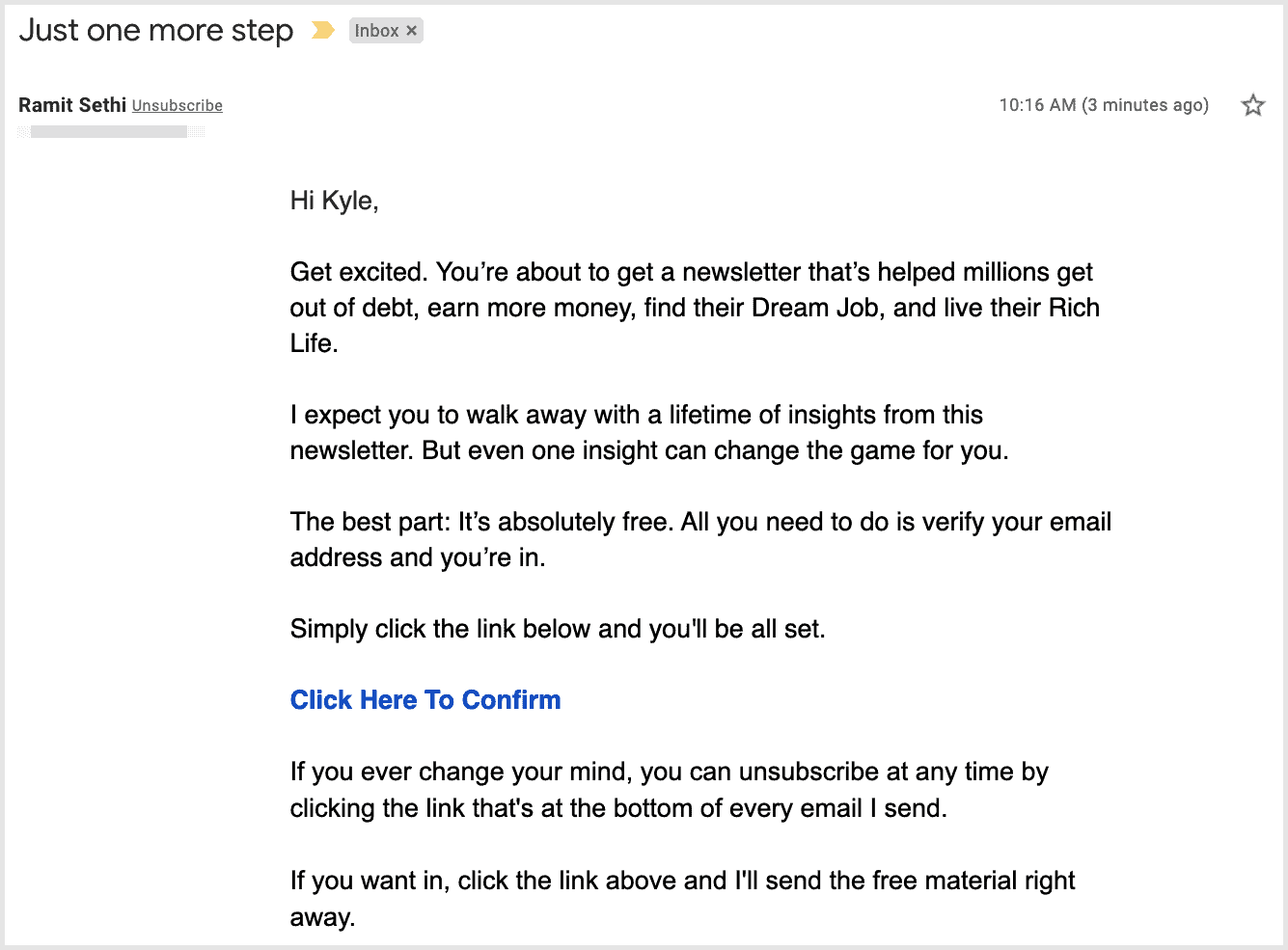
Cart abandonment emails are an important type of lifecycle email for ecommerce retailers.
Cart abandonment emails trigger when a customer adds something to their cart on the site, but leaves without placing the order. The email can offer a discount, or simply remind the person that they have an item waiting in their cart.
Here’s an example from StackSocial:
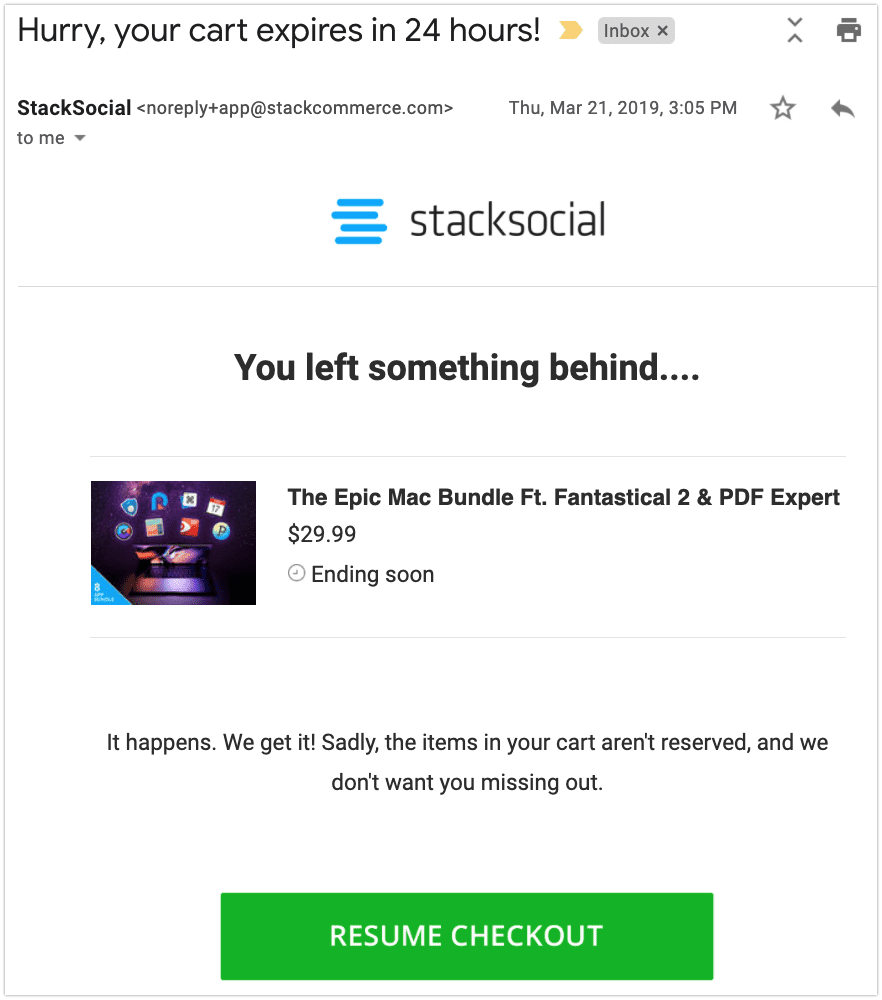
Many SaaS companies use lifecycle emails in a more advanced way: based on exactly what their users are doing with their software.
Common SaaS lifecycle emails include:
Onboarding emails for new customers. These often include quick tips on getting started with the product. Other times, they’ll link to a more in-depth user guide or video training.
Like this onboarding email from the project management SaaS Monday.com:
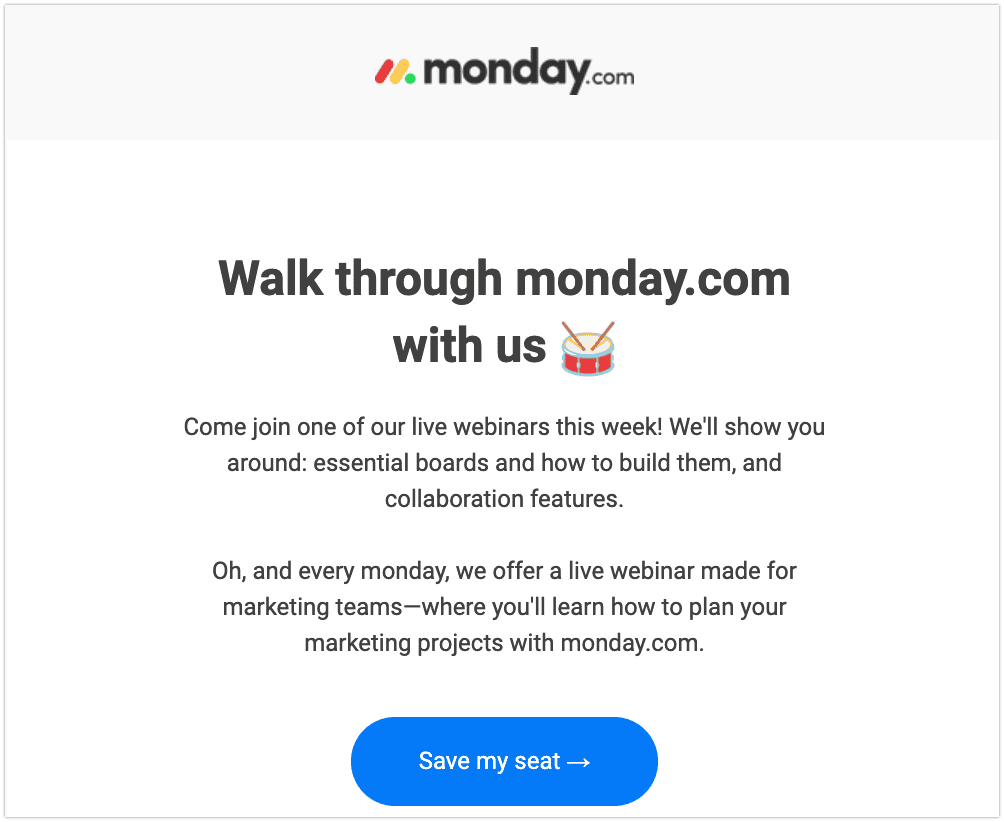
Usage limit notification emails. These automated emails get sent when a user is near their plan’s usage limit, with an invitation to upgrade to a higher plan. Or if the user is on a free trial, you can alert them before their trial ends.
Usage limit notification emails can also be used to remind customers when their monthly quota resets, so they’ll know that they can use the tool again. This can help establish a deeper usage pattern and decrease customer churn.
Here’s an example of this type of email from the audience research tool SparkToro:

Activation reminder emails are used to remind new customers to finish the signup or setup process. Or to start using a feature they haven’t tried yet. These triggered emails are also another great way to help reduce churn.
Here’s an activation reminder email from CoSchedule:
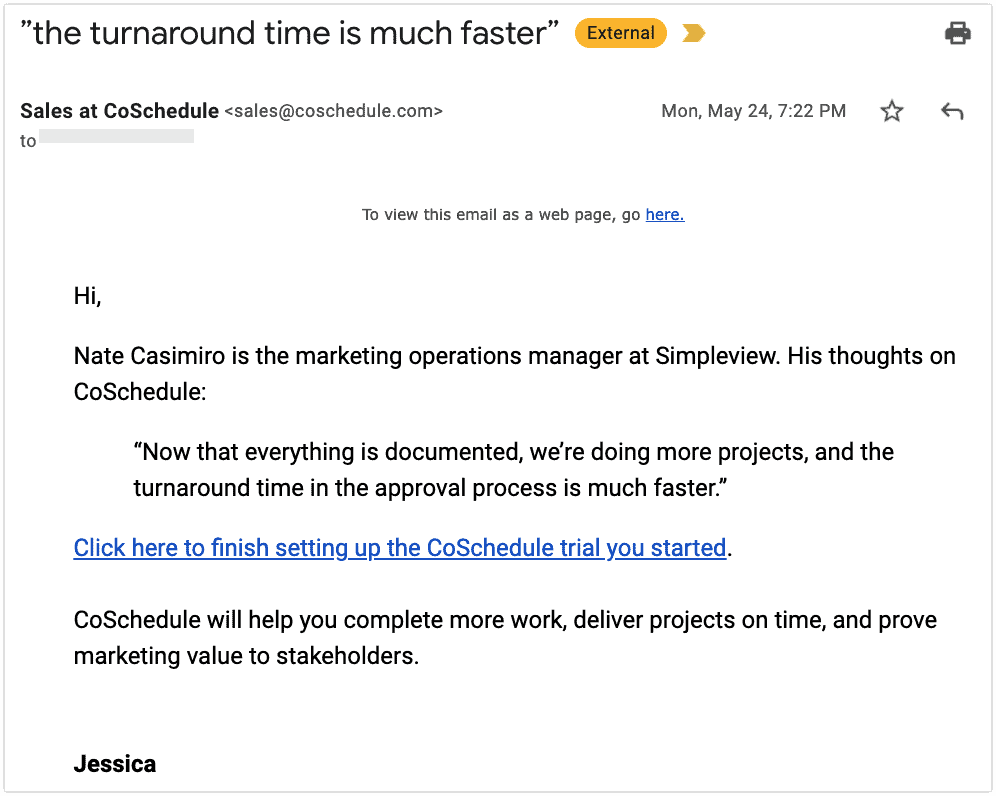
Lead Magnets and “Gated” Content
Lead magnets are the best way to build your email list.
Also called “gated” content, lead magnets are pieces of content that people can only see if they subscribe to your email list. (Or in some cases, only if they become a paying customer.)
The downside of this type of content is that it doesn’t usually bring in much traffic on its own. People don’t tend to link to it or share it as often as content that’s freely available. And it usually isn’t indexed by Google, either.
But it’s a great incentive to get visitors to give you their email address.
Here are a few kinds of content in this category.
Downloadable PDFs and White Papers
Downloadable content is probably the most popular type of lead magnet. And it’s the #1 strategy I’ve used to grow GrowthBadger’s email list.
You can offer a downloadable as a standalone piece of content. Like an annual report, research paper or ebook. Or a PDF guide like the ones HubSpot offers.
Downloadables are also a way to enhance existing content.
Like a checklist that helps people implement a process you’ve explained in a how-to video or blog post.
Or even simply a PDF version of an in-depth article. (If you don’t have time to create a new resource from scratch, I recommend repurposing a popular blog post.)
For example, Nick Kolenda offers a gated PDF version of his guide to pricing psychology:
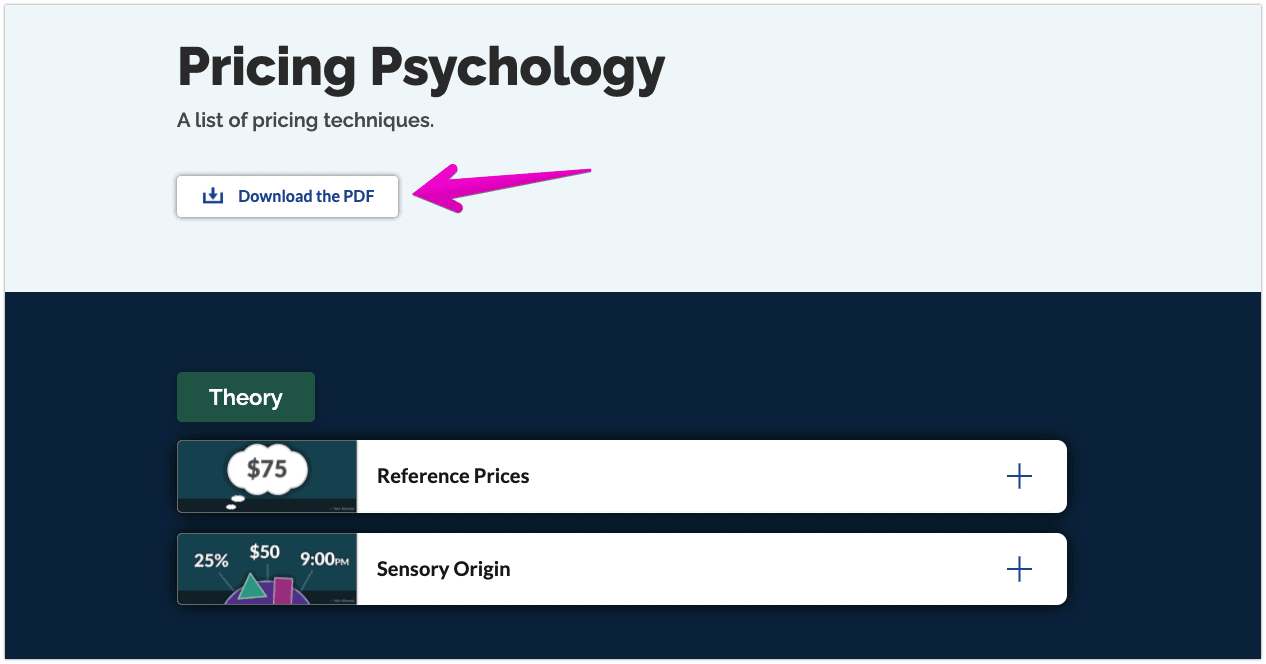
Gated Blog Posts
Gated blog posts are just what they sound like: blog posts that aren’t fully visible to non-subscribers.
For example, many posts on the Praxis blog are paywalled.
And many articles on the Backlinko blog require an email opt-in to view:
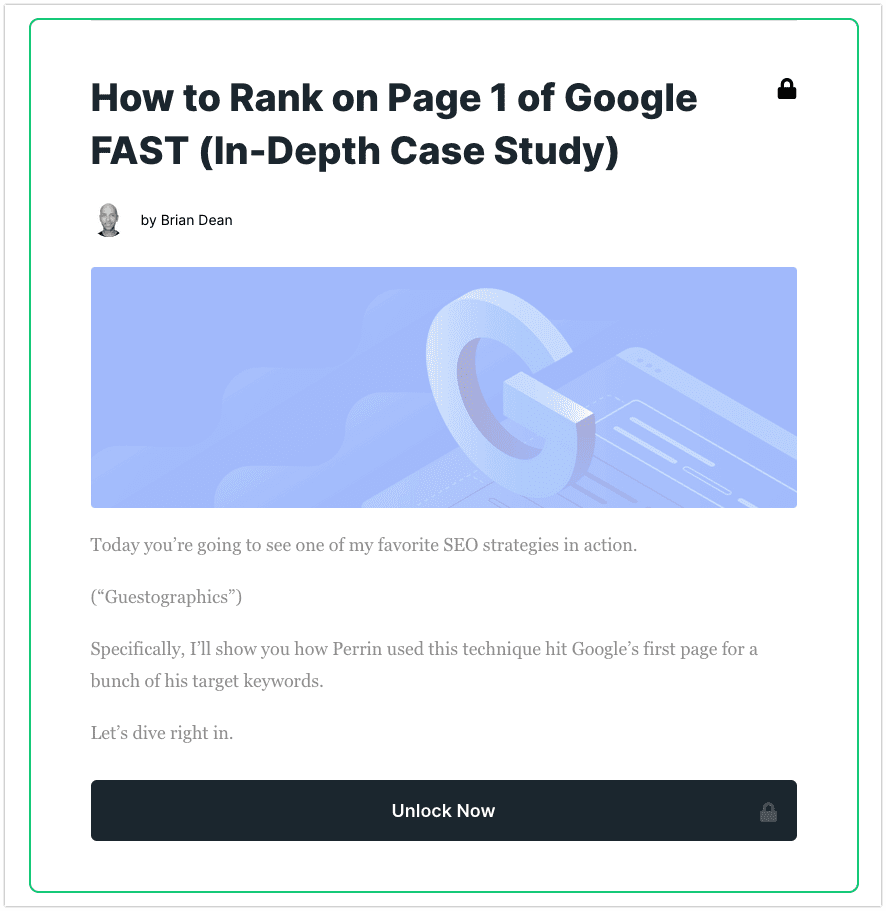
Swipe Files
A swipe file is a collection of curated content that people can use. Either directly or for inspiration. Often, swipe files are gated behind an email opt-in.
Like Tweet Hunter’s database of 100+ top-performing tweets. This single piece of content brought the company over 1,000 new subscribers in the first month alone, after founders Tibo and Thomas launched it on Product Hunt.
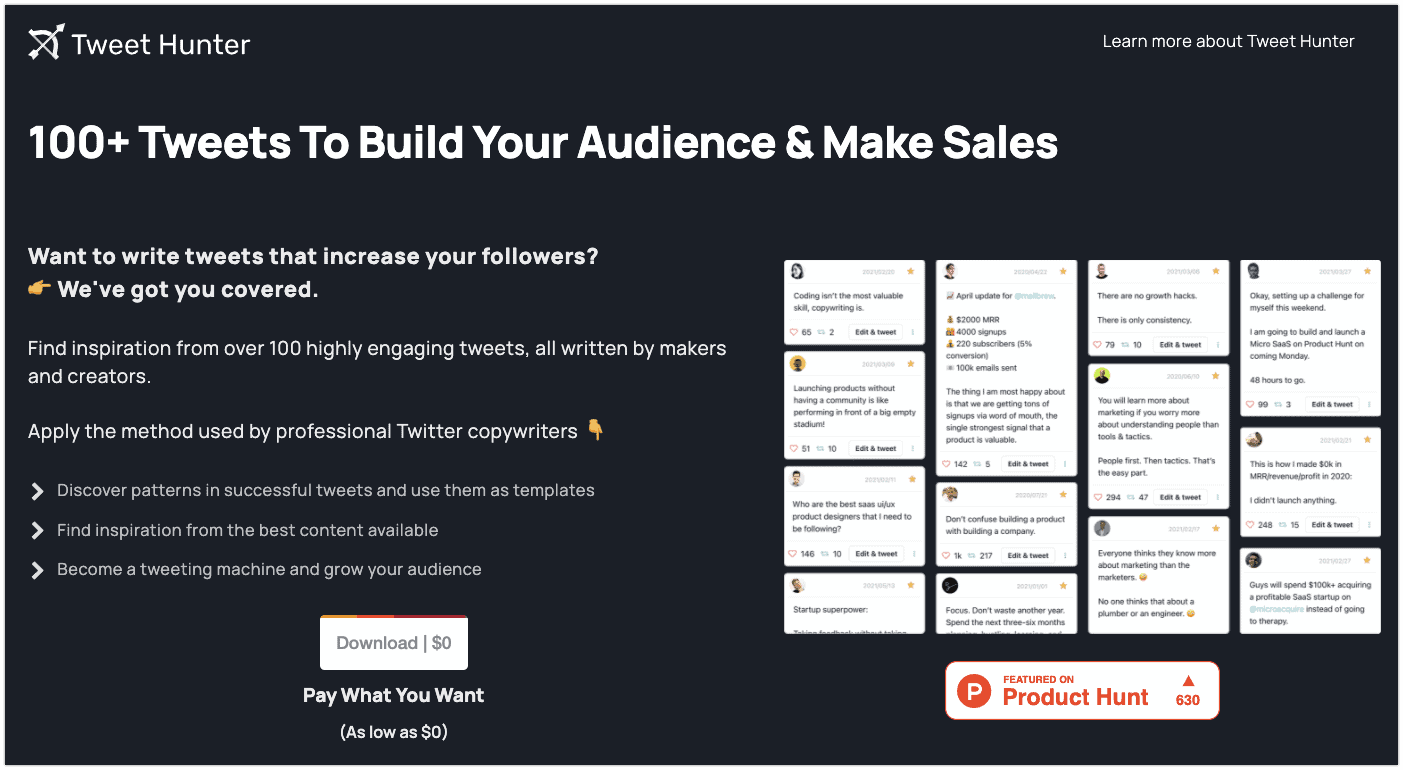
Webinars, Trainings and Product Demos
B2B businesses often require email opt-ins for their webinars, live and pre-recorded training videos, and product demos.
And most of the time, they require more information than simply an email address. That’s because getting more information lets them qualify leads better. And segment them for future marketing.
For example, Keap’s product demo video requires an email address, full name, business name and phone number.
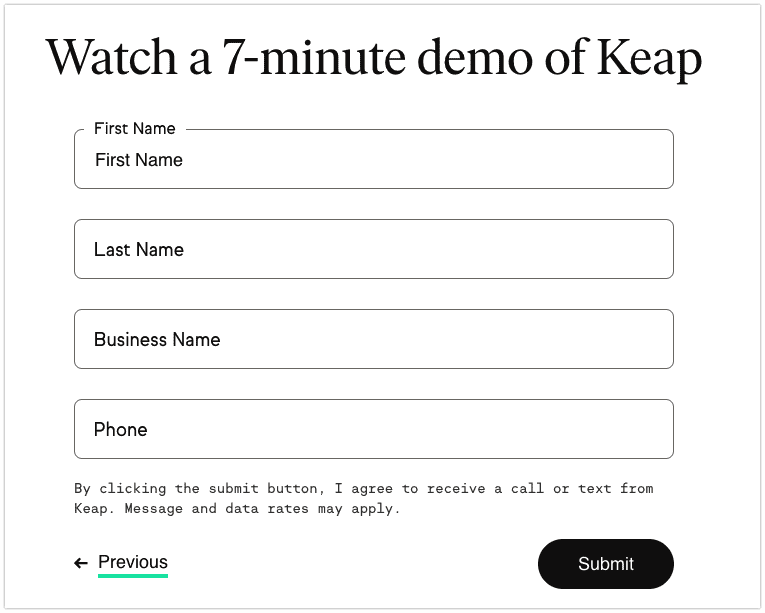
Wrapping up this section, I’ll mention that many free tools also function as lead magnets. More on those in the Interactive Content Marketing section of this post.
SEO Content Marketing
Google gets an estimated 3.5 billion searches per day.
With all that traffic up for grabs, it’s no surprise that content marketers love SEO. It’s one of the most powerful types of content marketing.
Many huge sites rely on an SEO-driven content strategy to bring in the majority of their traffic.
Like Wikipedia, Nerdwallet and Business Insider. According to SimilarWeb, all three of those websites get more than 70% of their traffic from search engines.
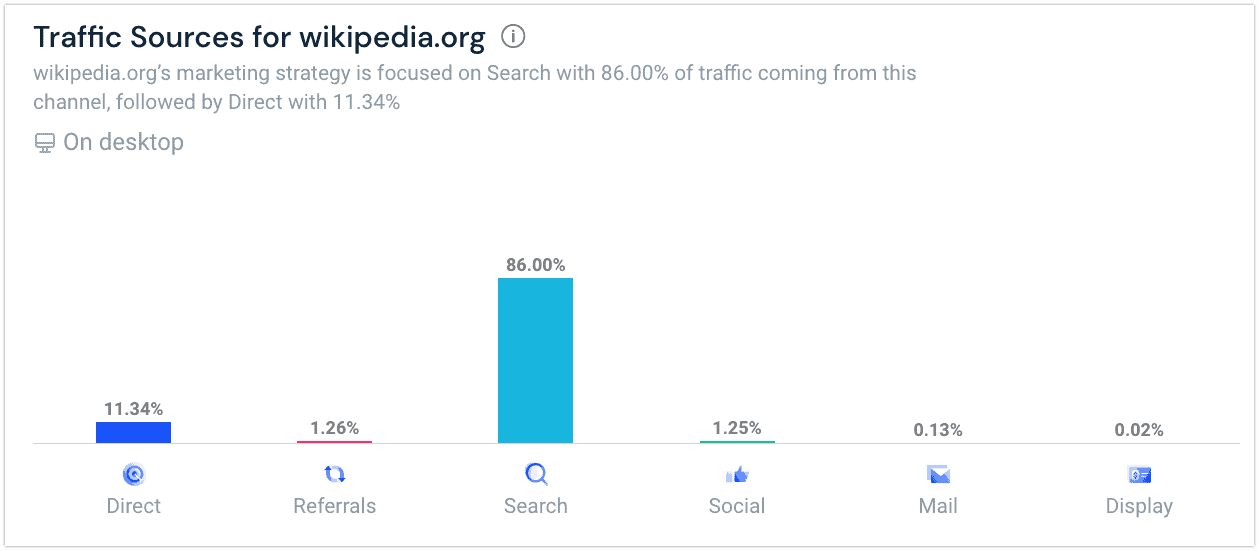
So what kinds of content work well for SEO?
Many of the content types covered in this article do. Like data-driven content, interactive content and lots of kinds of blog posts.
But zooming out, there are two main types of SEO content: keyword-focused content and link bait content.
Keyword-Focused Content
Keyword-focused SEO content is designed to bring in search traffic by targeting specific keywords. When people talk about SEO content, this is usually what they mean.
Keyword-focused SEO content can be either informational content or decision-making content, depending on the keyword.
One example of keyword-focused content is the “X vs Y” comparison post type we covered in the Blog Posts section above.
Another example is Buffer’s guide to “how to get more followers on Instagram”. According to Ahrefs, this blog post gets over 3,000 visits per month from Google.
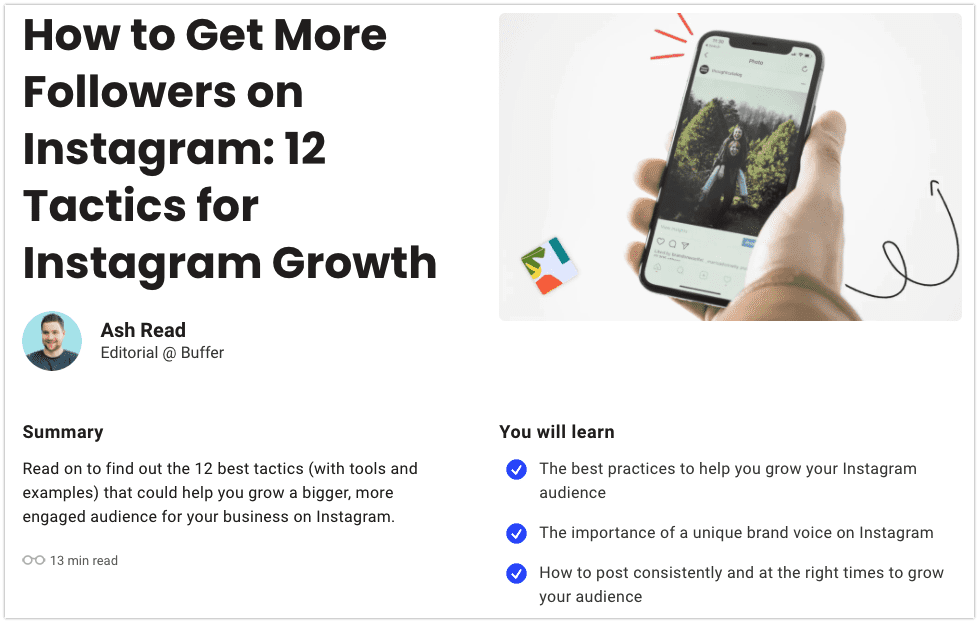
Looking at the article, it nails every condition you need for keyword-focused content.
Including on-page optimization in general, relevance for the implied search intent of the target keyword, and the inclusion of many related keywords the company found by conducting keyword research.
If you’re not sure how to tackle those things for your content, see the “optimize for search engines” section of my content optimization guide.
Link Bait Content
Backlinks are one of the very most important Google ranking factors. So a website with lots of high-quality backlinks has a huge advantage over its competitors.
But how can you get more backlinks?
Answer: link bait.
Link bait SEO content is made specifically to attract backlinks. This type of content is also called authority content, link-building content or “link magnet” content. And it’s almost always informational content.
Some digital content types attract more backlinks than others.
For example, data-driven content like original research.
Original research generates new statistics and facts. Which tend to get cited a lot in blog posts and news articles. That makes this kind of content a great way to get links from high-authority websites.
Like my traffic sources study, which attracted links from Forbes, Crunchbase and CoSchedule.
Or my blogger survey data, which has backlinks from Campaign Monitor, Backlinko and Podia.
Or my domain extensions study, which has been linked to by Mashable, Kinsta and Wix.
It’s been years since I first published those studies.
But they’re still bringing in new links for the GrowthBadger site on a regular basis, as you can see here:
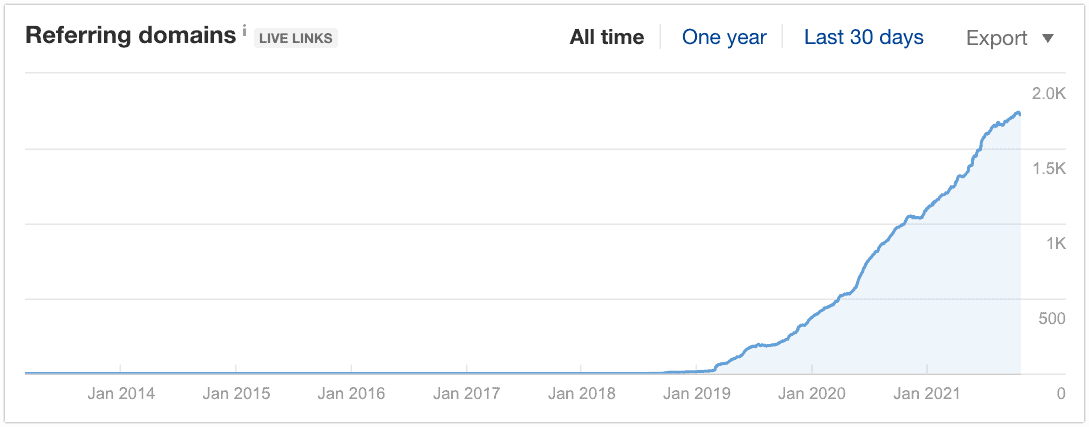
That’s the power of link bait.
Good types content for link baiting include:
- 10x content: content that’s 10+ times better than competing pieces
- Interactive content like tools — covered in the Interactive Content section of this guide
- Newsjacking content, which piggybacks on current events
- Controversial or newsworthy content, including publicity stunts
- In-depth how-to content like ultimate guides — covered in the Blog Posts section of this guide
- And data-driven content, like annual reports and original research (which we just talked about)
Note:
Some SEO content can double-dip. Attracting lots of links and also traffic from specific keywords.
When you can get your link bait content to rank for traffic-driving keywords, the result is a powerful self-perpetuating link magnet.
Stats posts that target keywords with high link intent are particularly good for double-dipping. And so are in-depth guides, like Drift’s Ultimate Guide to Chatbots. Which has backlinks from over 900 domains, plus ranks for over 2,000 keywords that bring in about 12,000 search visits per month.
Social Media Content
There are now 3.2 billion active social media users. And they each spend an average of almost 2 hours and 30 minutes on social media per day.
The most popular social networks in the world include:
- Facebook and FB Messenger
- YouTube
- WeChat / Weixin
- TikTok and Douyin
- Telegram
- Snapchat
- Quora
While each platform is different, social media content generally works best as informational content.
In other words, social media is great for building awareness and trust toward the top or middle of your content marketing funnel. But it’s harder to directly drive sales from it.
That’s why so much social media marketing content is geared toward driving engagement on the platform itself. Or getting email subscribers to monetize later.
The five best types of social media content that work on most platforms are:
- Memes, Humor and Inspiration
- Content Distribution Posts
- Instructional Content
- Questions and Polls
- Promotional Content
Let’s look at each of those more closely.
Memes, Humor and Inspiration
This type of content marketing is based on “quick hits.” Bite-sized posts that are easy for people to share with their friends.
Most viral content fits into this category, too.
Inspirational posts are usually either brief stories or quotable statements. Like this tweet by Arlan Hamilton, or this LinkedIn post by Simon Sinek.
Humor can be hard for brands to pull off. But it’s a great way to go viral, as the Wendy’s Twitter account has proven.
The same is true for memes. One good example of a brand using a meme is this Instagram post by Semrush:
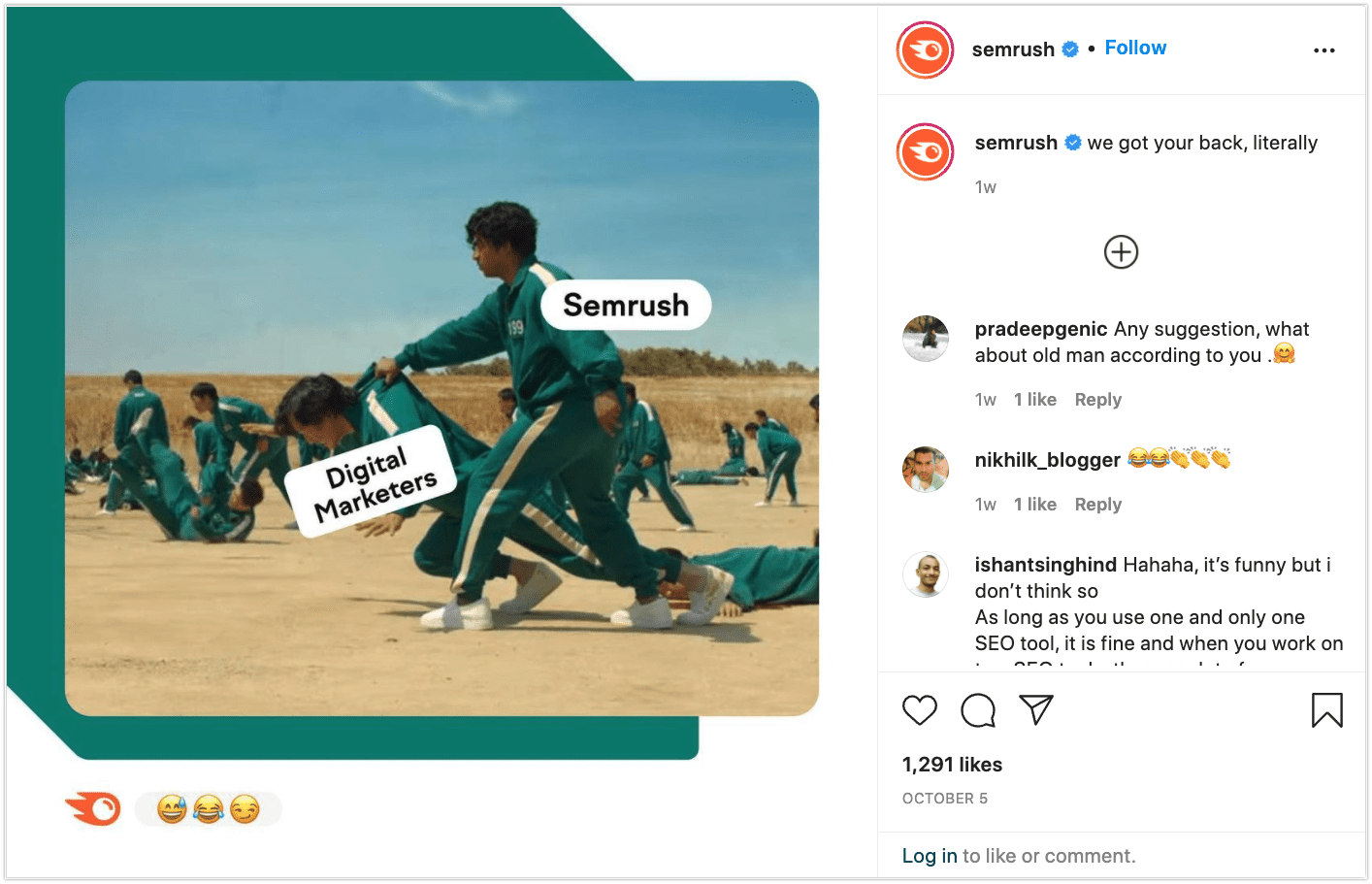
Content Distribution Posts
Content distribution posts are when you share a link to some other content you’ve published. Like a blog post or video.
These work best when they’re not just a link.
A better way is to use the “Viral Teaser” technique.
A Viral Teaser is a post that includes a preview of the content you’re sharing.
For example, if you want to drive traffic to a new video, you’d share a short clip of one highlight from that video. And then link to the full video.
Like Nathan Barry does in this tweet:
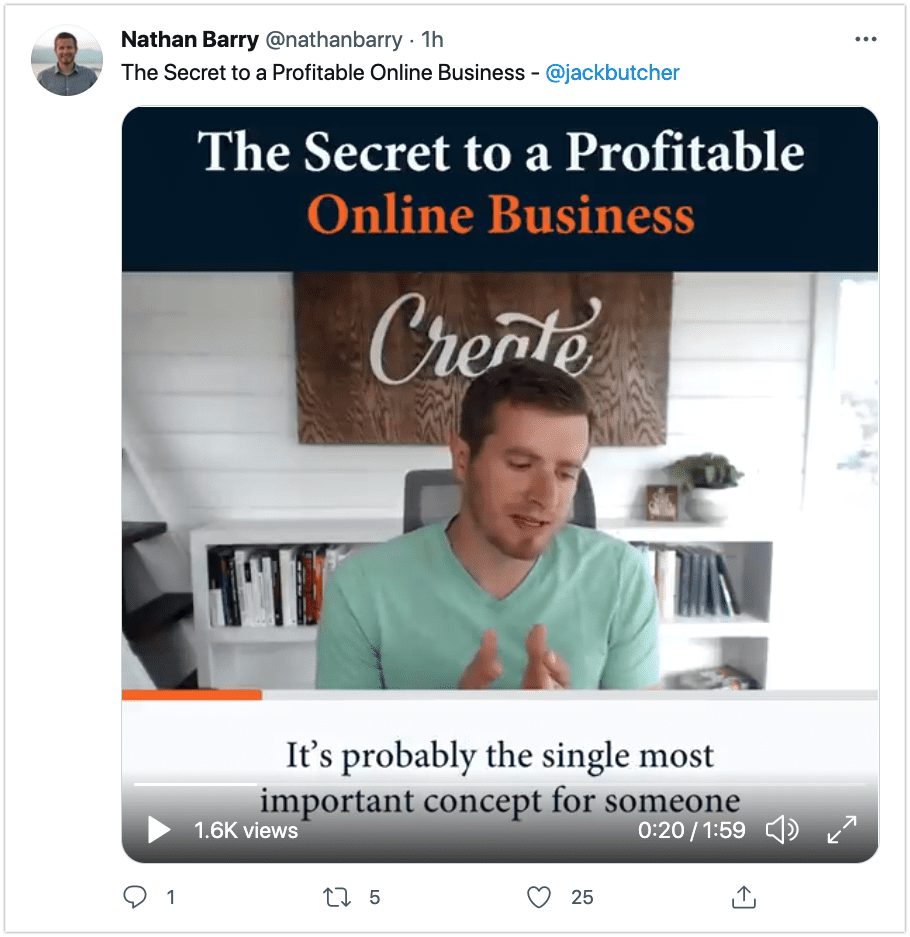
Viral Teasers work because they give people something to latch onto right there on social media. Making it much more likely that they’ll re-share it to their friends.
Instructional Content
People love instructional social content. Especially the B2B crowd.
This type of social media content can range from hours-long YouTube videos to quick hits on TikTok, massive Twitter threads or short, individual posts.
For example, this tweet by Shreyas Doshi:
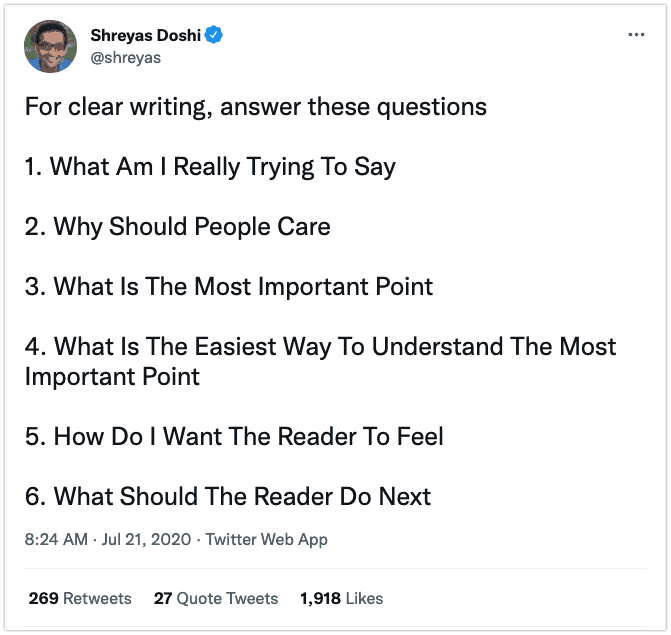
Instructional content is particularly popular on LinkedIn, Twitter, Quora and YouTube. As well as many interest-based subreddits on Reddit, like r/bodyweightfitness, r/Homebrewing and r/Entrepreneur.
Questions and Polls
Questions and polls are designed to be interactive. They’re a good way to encourage engagement, as well as to get information about your audience.
Like many question-and-answer sessions on Twitter Spaces, Clubhouse or Callin.
Or this guessing game post on Amazon’s Instagram account.
Or this Facebook post by Marie Forleo (which is also a bit of a promotional post for one of her courses):
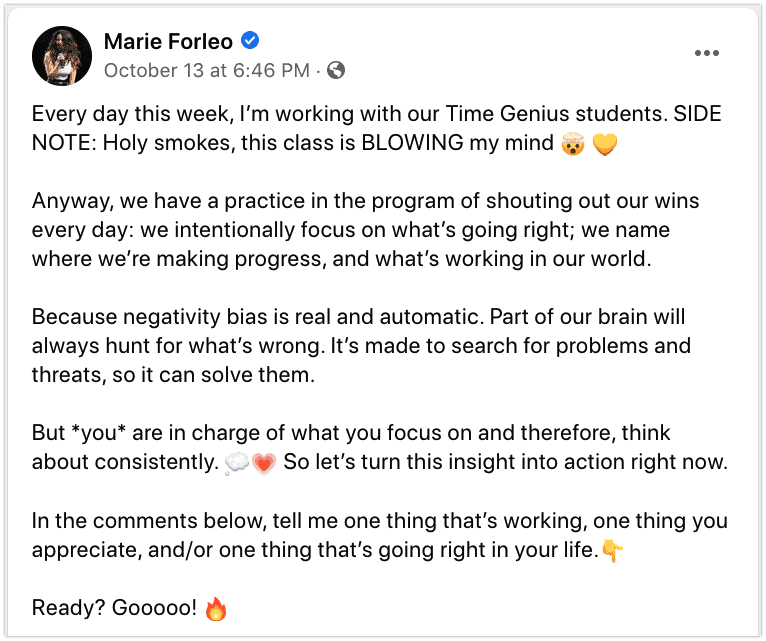
Promotional Content
Unlike most other types of social media content, promotional content is meant to generate sales. Which puts it 100% in the decision-making content category.
Promotional social media content includes special offers and discounts, product announcements and pre-order invitations. And any other kind of social content that’s focused on getting people to buy or sign up.
For example, this course launch Tweet from Ali Abdaal.
Or this promotional Facebook post from Foot Locker:
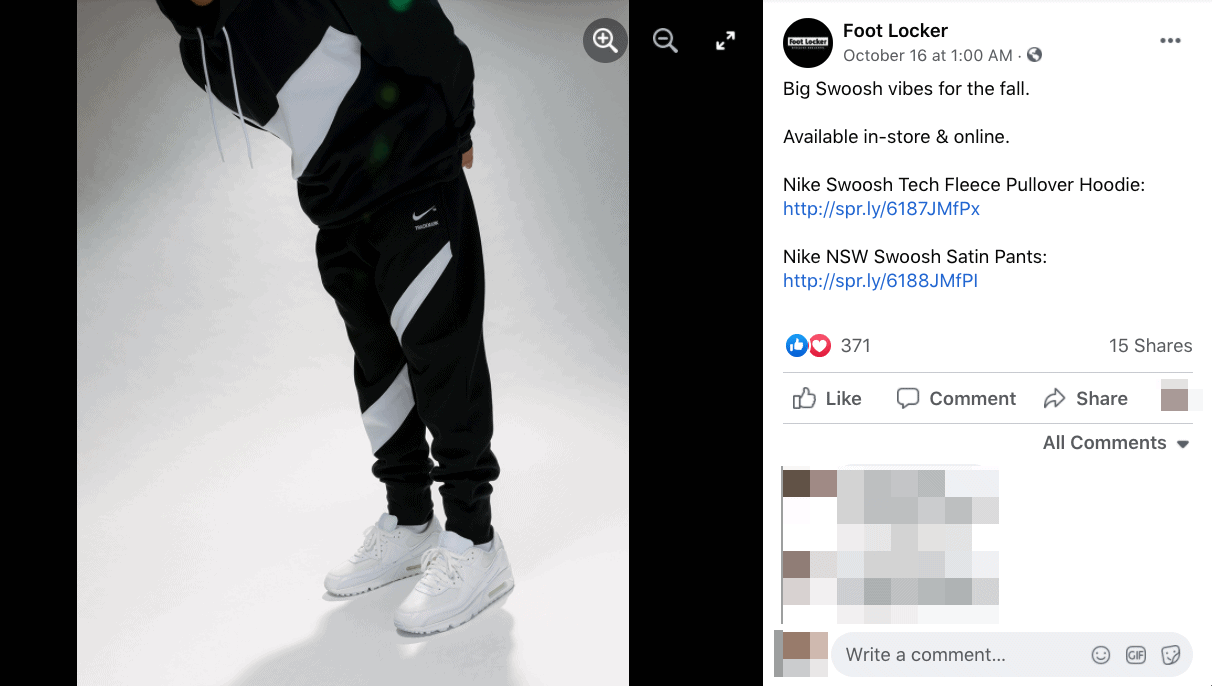
Of course, social media works best when other people are sharing your content, too. To see how to get more shares on your work, see the “optimize for social shares” section of my content optimization guide.
Interactive Content Marketing
Interactive content marketing includes free tools, courses, quizzes, apps and more.
Naturally, it’s one of the hardest kinds of content marketing to create.
But that also means it’s a less crowded space. So it’s easier to stand out with interactive content than with a simple blog post, for example.
For the same reason, interactive content also tends to get a lot of backlinks and social shares.
This kind of content marketing can deliver either informational content or decision-based content.
Here are the most important types of interactive content marketing. And proven examples of each.
Tools and Calculators
Tools and calculators can be a great way to earn backlinks, search traffic and social shares.
For example, Bankrate has built its business with free personal finance calculators. The site has over 100 different calculators tackling subjects like retirement income, mortgage rates, life insurance and more.
According to Ahrefs, Bankrate’s top three calculators alone bring in almost 2.3 million search visits per month:
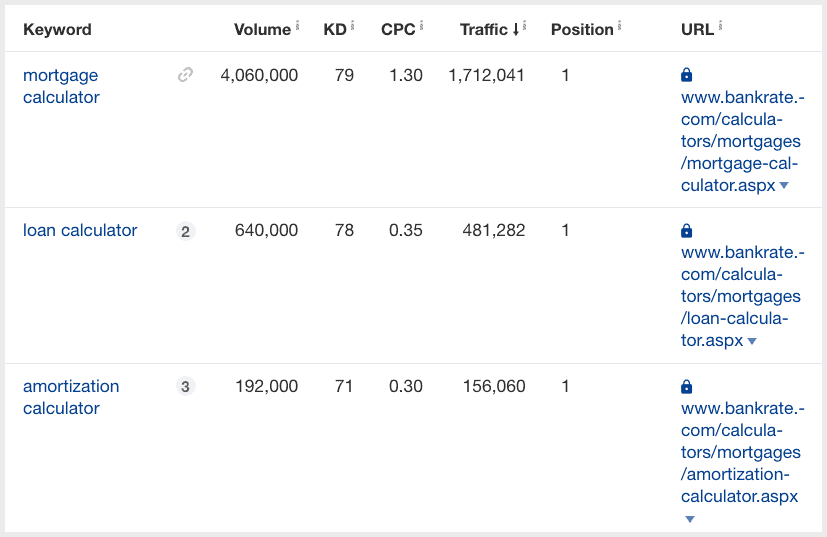
Other free tool examples include Canva’s color wheel, Patagonia’s Action Works, and Shutterfly’s wedding hashtag generator.
As well as pretty much any SaaS that offers a free tier.
Free Courses
Interactive free courses can help educate your audience, while also warming them up to an eventual sales pitch for a paid product.
For example, Ableton’s “Learning Music” course. Which helps to sell their music production software.
Or Tara Brach and Jack Kornfield’s 40-day meditation course. Which brings in customers for their paid courses.
Or Codecademy’s self-paced coding courses. The basic courses are free, but guidance and completion certificates require a paid membership.
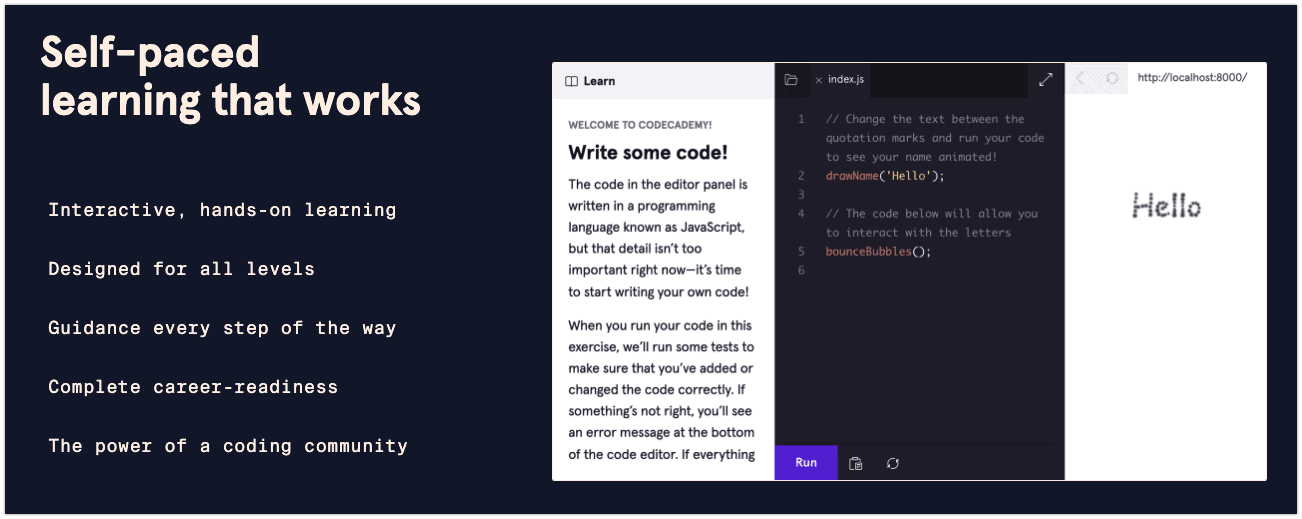
Quizzes and Assessments
A quiz or assessment offers people a way to learn something about themselves or their situation.
Some quizzes are just for fun, like in the case of Disney’s “which character are you” quizzes or Wendy’s Sodiac Readings microsite.
Other times, a quiz or assessment can deliver useful insights. Like Truity’s personality tests or WebFX’s website grader.

Applications
Full apps are probably the most expensive kind of interactive content to create.
But that also makes it easier for them to get attention. (And mobile apps unlock an entirely new path to customer acquisition: mobile app stores.)
One example is Exploding Topics, a web app for finding new search trends.
Another is Adobe’s Photoshop Express mobile app for editing photos.
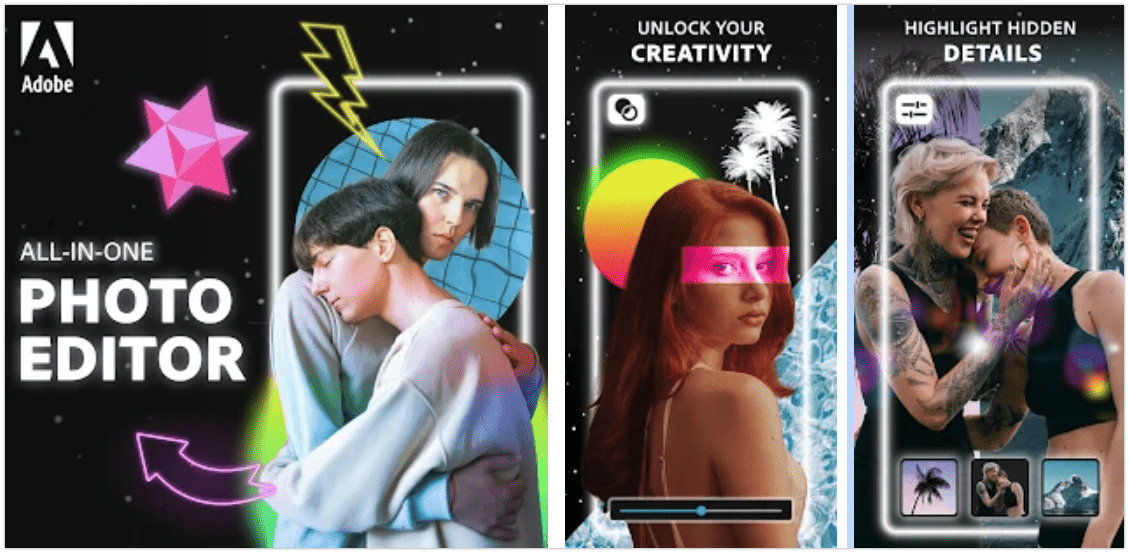
Templates and Spreadsheets
Templates are another great type of interactive content marketing.
They can take pretty much any form. Like this Notion template of OKRs from Buffer. Or Nira’s productivity templates for Trello, Coda, Google Docs and more.
But most templates are offered in a spreadsheet format. Like Smartsheet’s free inventory templates:
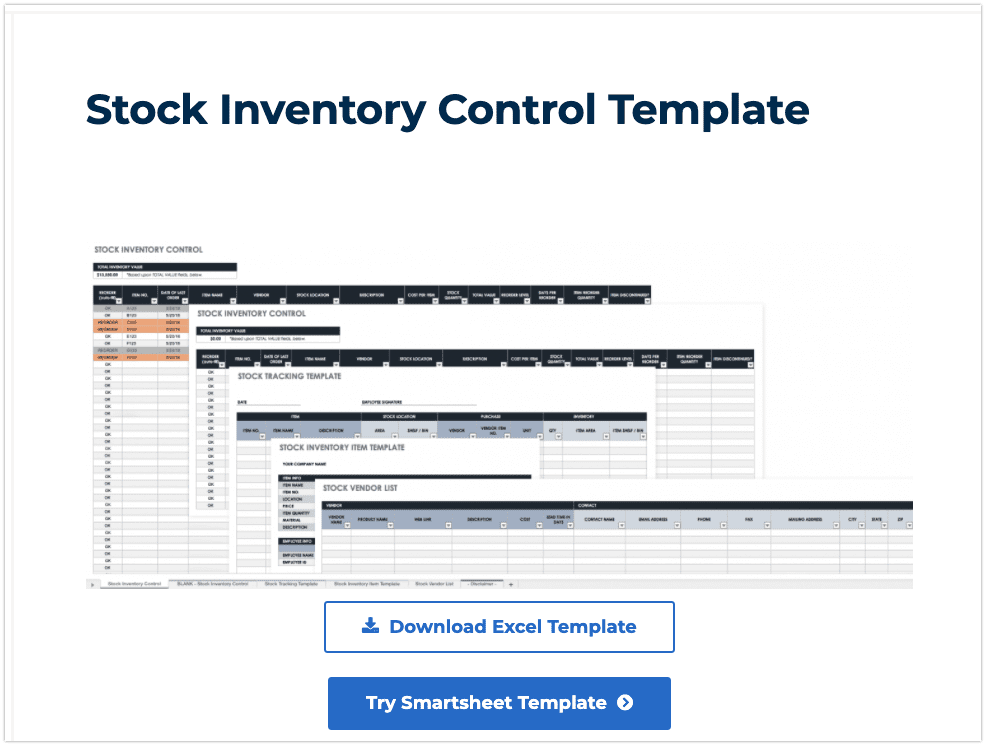
Other Interactive Content Marketing Types Include:
Communities and niche social media sites, like the Bodybuilding.com forums. Or Behance, which Adobe acquired in 2012 and now uses to promote their software and events.
Question-and-answers like Avvo’s “ask a lawyer” feature, AMAs on Reddit, and live Q&A sessions on Twitter Spaces and Clubhouse.
Interactive blog posts like The Pudding’s “Ranking the Biggest NBA Finals Carry Jobs” or my own resource of 100+ Effective Content Marketing Examples.
Dedicated sites (microsites) like the purposefully-bad User Inyerface.
Live presentations, events and conferences — whether in person or online. The speakers at MozCon and exhibitors at CES are all in effect doing content marketing.
Free samples of physical products like food and makeup.
Books and Ebooks
Books might be the oldest type of content marketing.
Most books are simply products. But when they’re used to pitch opt-ins or additional paid products or services, they become a form of content marketing.
Naturally, books always contain informational content. But sometimes they feature decision-making content too.
James Clear’s bestseller Atomic Habits is one example of a book that’s used as content marketing. It includes many links to additional downloadable content and bonus chapters. But to get them, you need to opt in to James’s email newsletter.
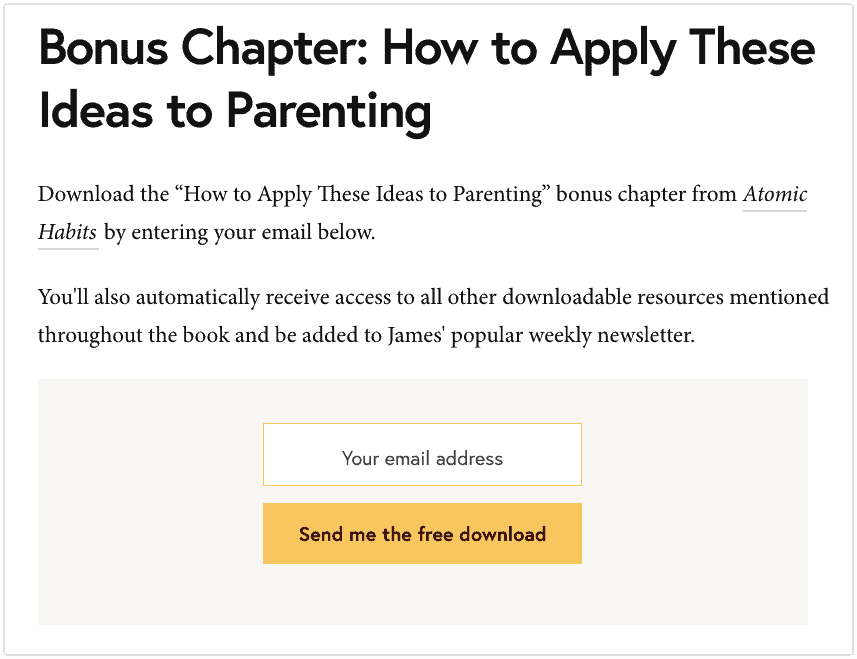
Similarly, Donald Miller’s Building a StoryBrand acts as top-of-funnel content for the author’s higher-priced courses, conferences and workshops.
Traditionally published books are also incredible tools for building credibility. And they offer exposure in different marketing channels, like bestseller lists and Amazon.
Another way you can use a book for content marketing is by offering it for free, as a lead magnet.
You can get the best of both worlds by offering a free ebook as a lead magnet… and also selling it on Amazon.
Like Thomas Frank’s book, 10 Steps to Earning Awesome Grades (While Studying Less). The book is available on College Info Geek for free in Kindle, EPUB and PDF formats.

Actually, Thomas also sells the exact same book on Amazon for $0.99 — with 1,150 ratings and an average of 4.6 stars. So he’s getting exposure in both places, plus some extra income. The best of both worlds.
Like other lead magnets, free books are also great way to repurpose existing content. It doesn’t take much to turn a series of blog posts or even a video transcript and turn it into a free ebook.
Press Releases
Press releases are designed to help businesses get covered in newspapers, TV shows and blogs.
As a result, press releases are focused on informational content. Their purpose isn’t to make a direct sale.
Press releases can be used to bring attention to anything that might be newsworthy.
For example:
Important events like the receipt of an award, a new executive hire, financial results, a publicity stunt or a conference. Or any impactful strategic move, like Hertz placing an order for 100k Tesla cars.
Research reports, like the results of a survey by talent agency Robert Half or the online retail forecasts by Forrester.
New products, like Apple’s new MacBook Pro lineup.
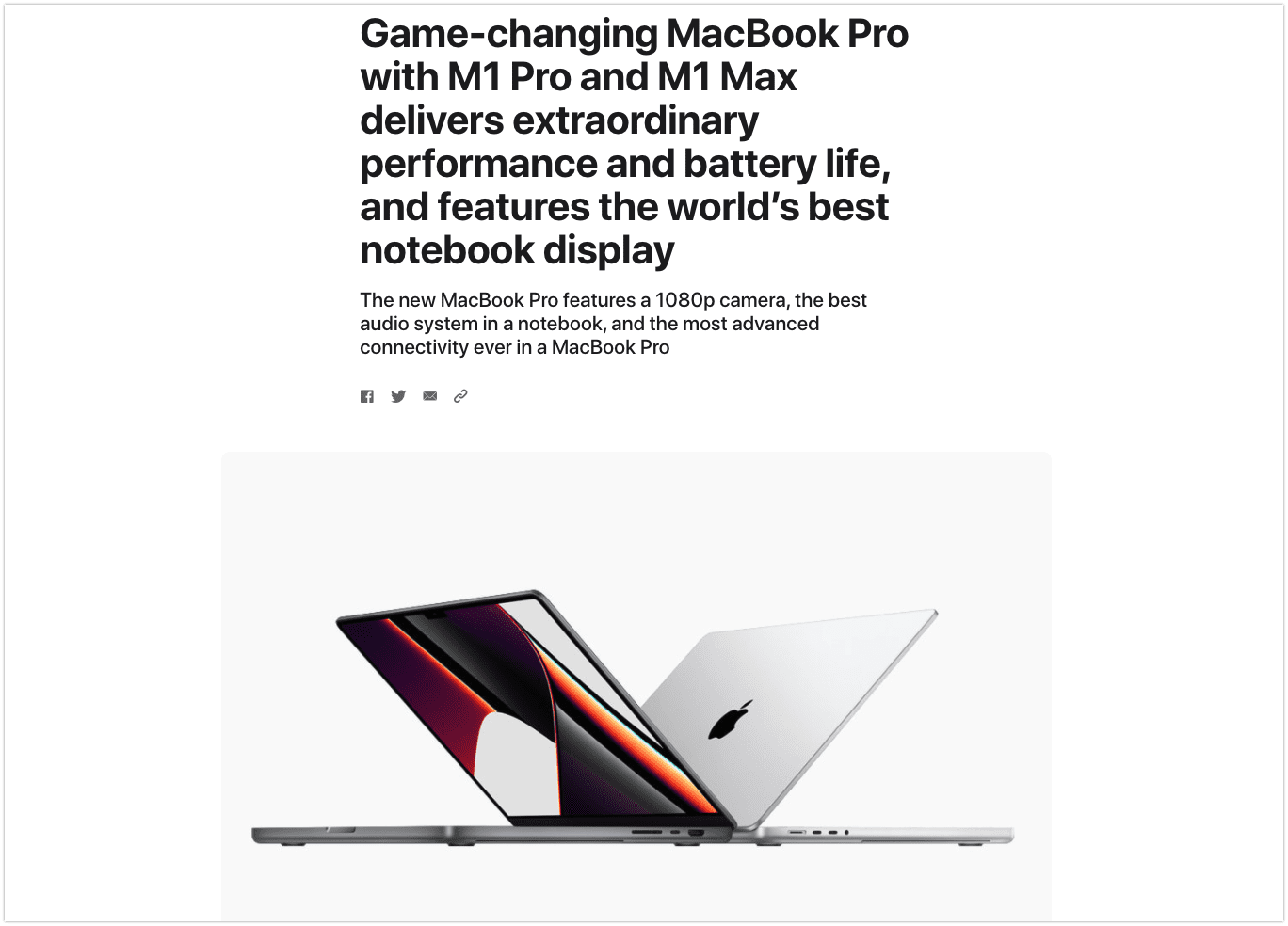
Good press releases contain:
- An attention-grabbing headline
- A one-sentence summary as the hook
- Skimmable body text
- High-quality images that can be used by the press
- Boilerplate info about the business
- Contact info
Most pros recommend distributing your press release using a service like Newswire.com or PRWeb. And also directly emailing journalists who might be interested. (Tip: BuzzSumo is great for finding relevant journalists.)
Other Visual Content Marketing
Beyond video and interactive content, there are plenty of other types of visual content marketing. Most of them are best suited to informational content, building awareness and bringing in traffic.
Let’s look at the main types.
Creative “What Ifs”
Creative “what ifs” are the newest type of content marketing in this category. And they tend to get a lot of backlinks and social shares.
Here’s how they work:
You take something that already exists and get it redesigned in a different way. Like a piece of pop culture everyone knows… with a unique twist to make it new.
For example, The ToyZone recreated 20 famous album covers using LEGO. And it attracted backlinks from big sites like Esquire, Pitchfork and Mental Floss.
While HomeAdvisor imagined what The Simpsons settings would look like in the style of a Wes Anderson movie. That piece of content received coverage from GQ, Today, Rolling Stone and Nerdist. And it was shared over 800 times on social media.

Infographics
Infographics are probably the most common type of visual content marketing, aside from video.
They’re basically large images that contain both text and graphics. Infographics usually look like maps, posters, or big graphs.
For example, the “Perceptions of Perfection Across Borders” infographic by Superdrug.
To create it, the company had designers from 18 countries Photoshop the same image based on their cultural perceptions of beauty. The results have been shared over 34k times on social media.
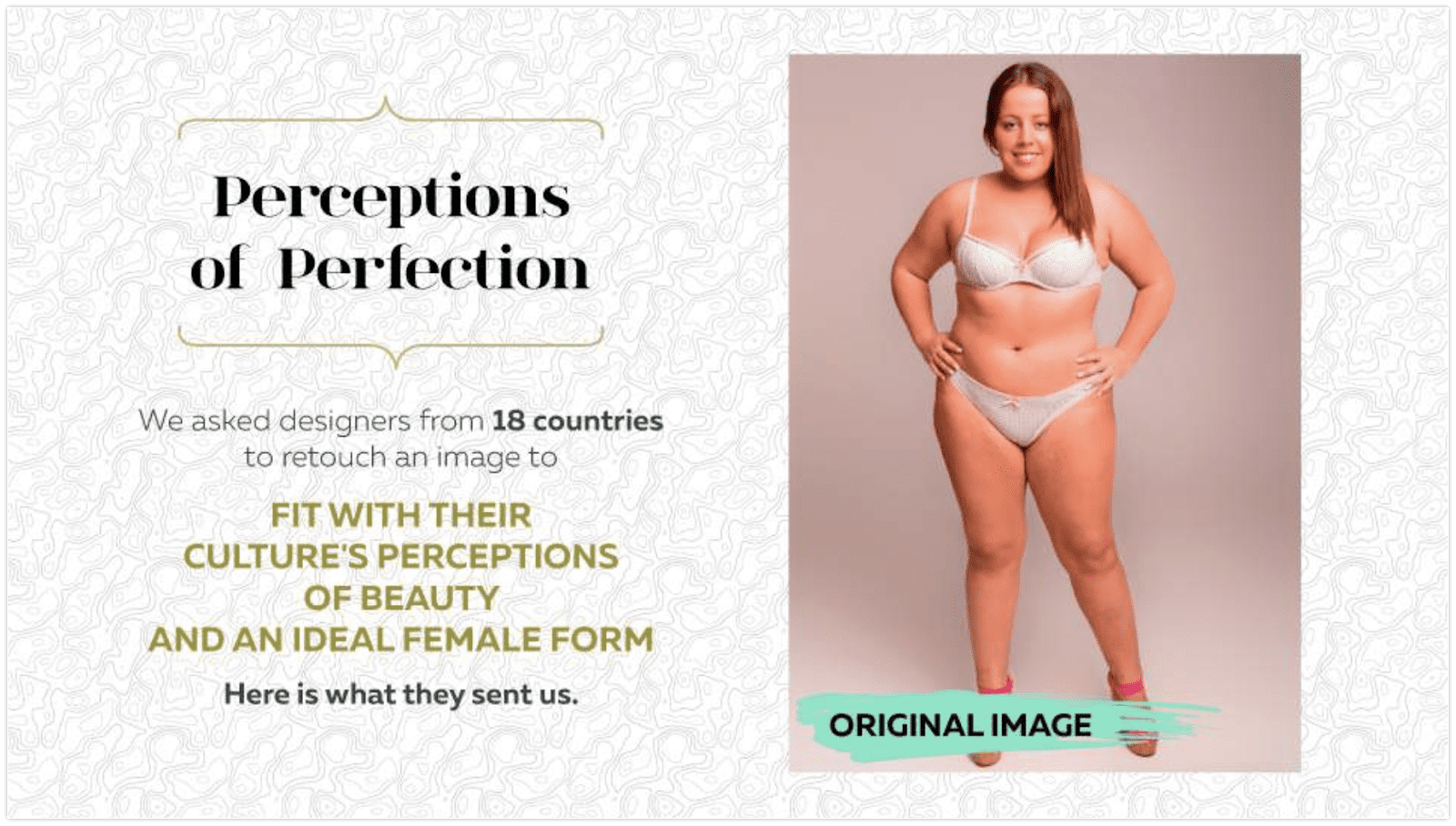
Slide Decks
Using SlideShare or Linkedin carousel posts, you can promote a slide deck of information to a massive B2B audience.
This works especially well with research reports.
Like the Digital 2021 Global Overview Report slide deck, which was viewed almost 900k times on SlideShare in the first several months after publishing.
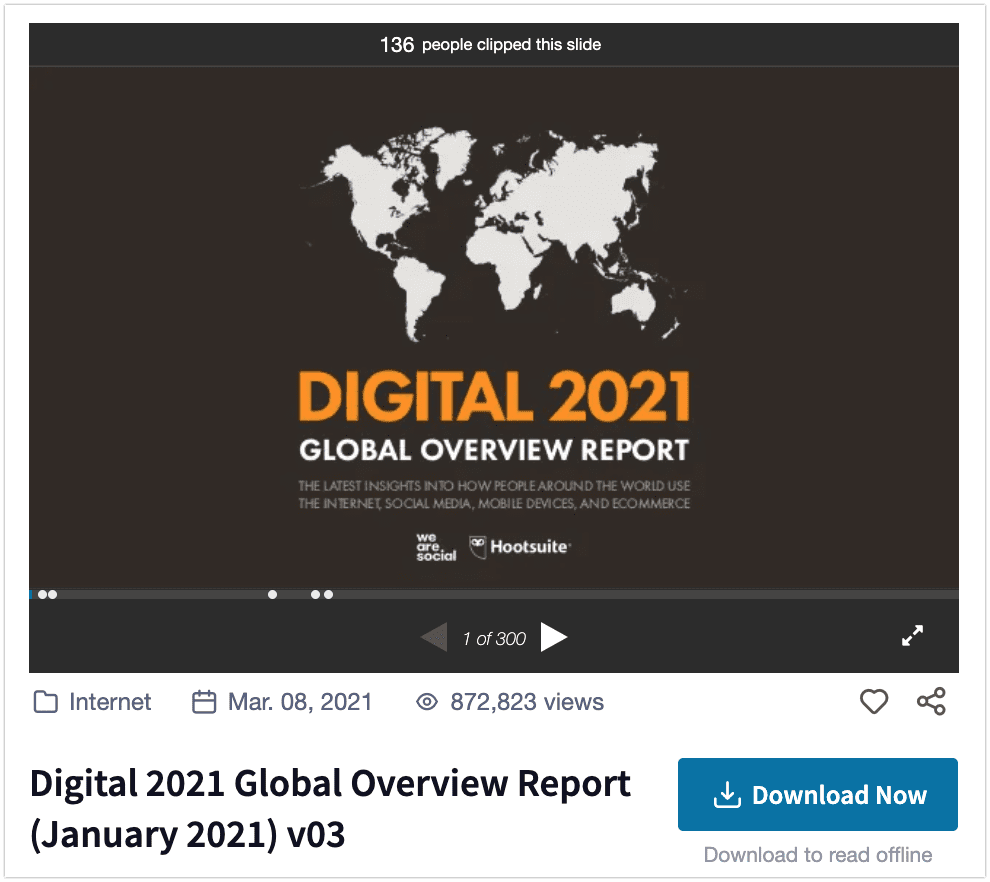
You can also share your slide deck via an Instagram carousel, like Buffer did with highlights from their 2021 State of Remote Work report.
Data Visualizations
Data visualizations take hard-to-understand data and present it in a visual way.
The Kurzgesagt YouTube channel and the Chartr newsletter both do this really well.
But one of the best examples of this type of visual content marketing is Fortinet’s animated cybersecurity threat map. It’s a real-time representation of the world’s cybersecurity attacks, illustrating how important it is to be protected against them.

Conclusion
And that concludes this list of every type of content marketing.
Now, I’d love to know what you think.
Are there any that I missed?
Or did one in particular catch your eye?
Drop a comment below to let me know.

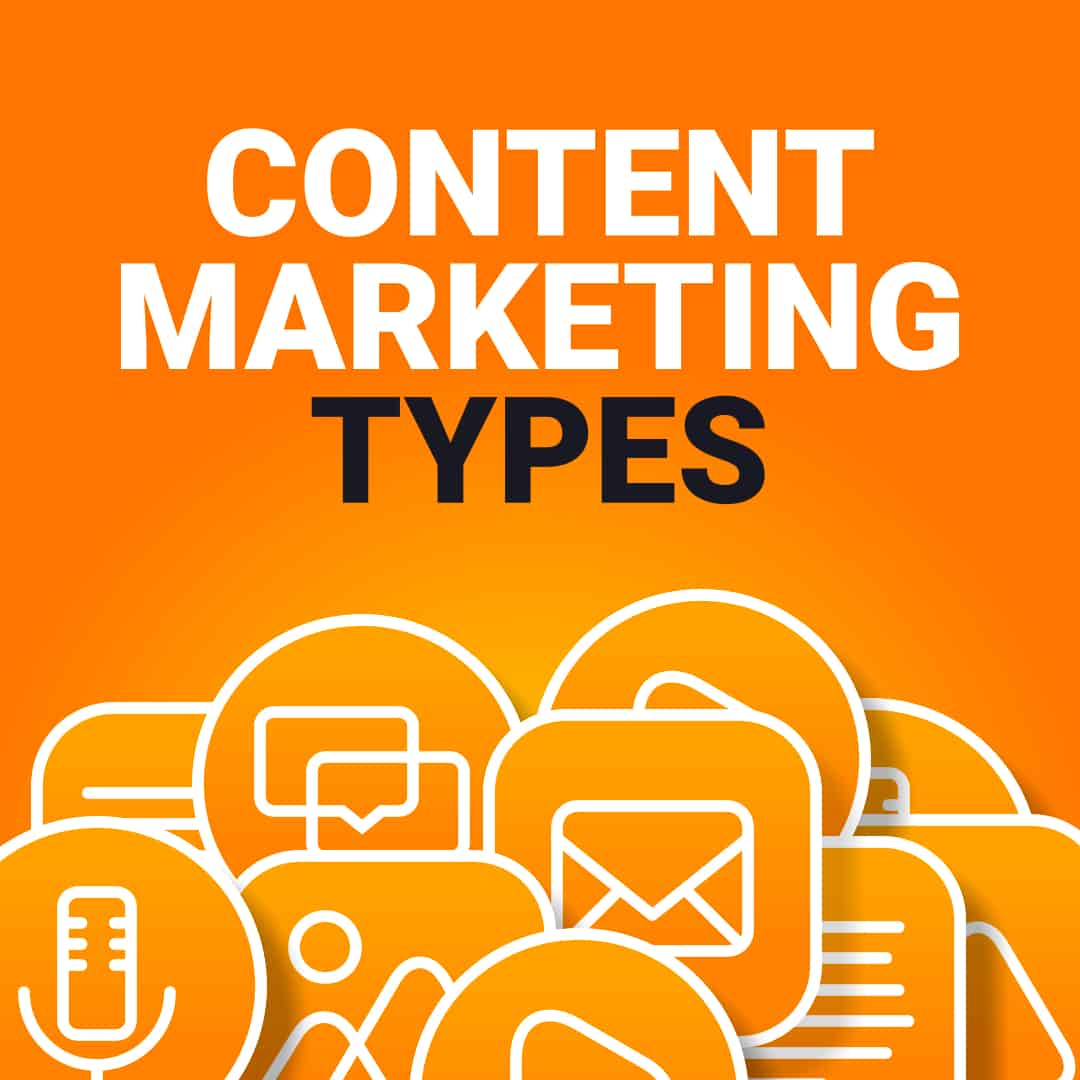
Great list, Kyle. Lots for me to chew on.
You did miss one kind of business podcast; storytelling. It’s not really a monologue or an interview, but instead a group of people who tell a story about how something happened. Business Wars does it really well.
Maybe that isn’t as common as the kinds you talked about though.